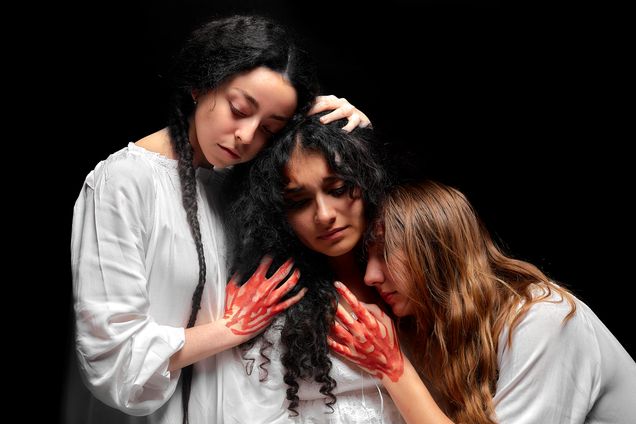news
Dangers of Response: “I modi” and its Censorship
by Iakoiehwahtha Patton
Erotic imagery comprised a significant portion of artistic production in Renaissance Italy. It is within this cultural context that the reclining nude became an archetype and a contested site where censorship could be enacted. The nude was particularly criticized for its sinfulness, so much that in the late fifteenth century, the Dominican Friar, Girolamo Savonarola, fervently preached against artists who painted “figures with bare breasts.”1 With the rise of the Protestant Reformation, these objections to the naked body only increased by the turn of the sixteenth century.2 It is not surprising, then, that most erotic images disappeared over the course of the sixteenth century, despite the importance of the erotic within Renaissance visual culture.3 This relationship between art and censorship brings our attention to Giulio Romano’s I modi (c. 1520s), which represents the most controversial erotic visual material to emerge in sixteenth-century Italy.
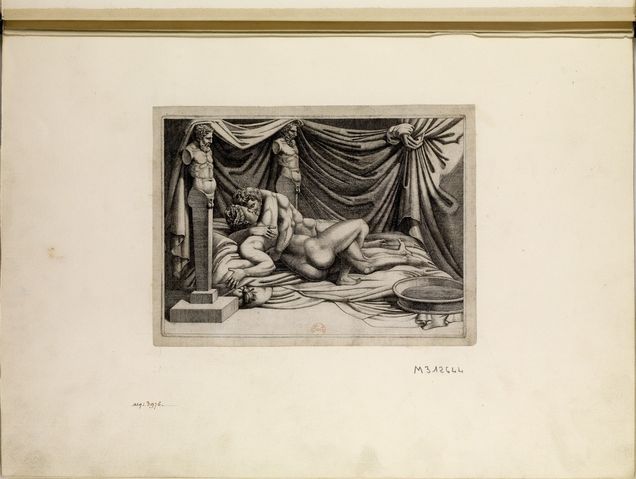
I modi saw wide-scale destruction to the extent that all that remains of the original sixteen images in the series are fragments, two engravings, and a woodcut. Our knowledge of the original drawings and print series primarily comes from the Italian author Pietro Aretino’s sixteenth-century sonnet book published in Venice (1526), decades after the original drawings.4 In Italian, the title I modi has many interpretations, but it has been consistently translated into English as The Positions.5 However translated, the title describes what the series entails: sixteen heterosexual couples engaging in sexual acts in varying positions. The title and the figures are presented under no mythological guise or allegory. Rather than using Classical mythological imagery that borrowed from antique paradigms, I modi divulges itself as unmistakably and primarily erotic. Previous art historical scholarship has acknowledged the inherent eroticism of I modi but has done so within the broader context of erotic images that pervaded Renaissance Italy by focusing on I modi’s origins.6 In this essay, I nuance previous analyses by highlighting I modi’s reception and viewer participation within the discourse of censorship. Through the series’ unmitigated imagery, I modi became a provocative assemblage, building upon an antique topos with blatant sexual subject matter that is enlivened through viewer engagement. Much like the genre of the nude image, I modi, consequently, became a contested site that provoked widespread censorship.
The story of I modi’s production and dissemination unfolds in multiple parts. In the 1520s, Giulio Romano inherited Raphael’s lucrative and prestigious workshop in Rome after his death.7 In this position, he established an advantageous relationship with Marcantonio Raimondi, a printmaker to whom Romano supplied drawings.8 In Le vite de' più eccellenti pittori, scultori, e architettori (1550), Vasari provides the fullest written source that concerns the creation and reception of I modi.9 Yet even with Vasari’s text, questions remain regarding the intention and patronage behind Romano’s original drawings.10 In Le vite, Vasari indicates that Romano made twenty drawings of heterosexual couples engaging in explicit sexual acts under no mythological veil. These drawings were then given to Raimondi, who made a set of engravings based on Romano’s drawings in 1524. Influential author and satirist Pietro Aretino then wrote salacious sonnets to be paired with each image, which were drafted into a book in 1526. It is at this point that Pope Clement VII became enraged, the prints were banned, and Raimondi was imprisoned.11 By the time the scandal occurred, Romano had accepted a position in Mantua at the court of Federico Gonzaga and, luckily for him, remained unscathed by the events in Rome.12
In reading Le vite, art historian Bette Talvacchia argues that Vasari’s intention was not to recall events accurately, but rather that Vasari intended to use the story of I modi as a warning against “outrage.”13 Vasari explicitly states that “the gifts of God should not be employed, as they very often are, in things wholly abominable, which are an outrage to the world.”14 Vasari was not only writing at a moment when the modern concept of the “artist as genius” was emerging, but was also an active creator of this myth. This condemnation is clear within its original context; in Le vite, Vasari constructs the biographies of famous Renaissance artists whilst defining boundaries for acceptable artistic behavior. Therefore, Vasari not only condoned I modi’s censorship, but actively participated in it by cementing the scandalous legacy.
Vasari’s text suggests that I modi’s replication and dissemination in print called for intervention. I modi was published during a historical moment in which erotic engravings as a genre were novel. In the late fifteenth century, erotic engravings were beginning to be produced for the art market, which allowed for wider accessibility and a new merchant-class clientele.15 Previously, erotic images were largely commissioned by and executed for the elite, whose social position guaranteed a controlled viewing context.16 This speaks to the strict boundary of what constituted fine art as opposed to what was seen as vulgar imitations of it. This boundary was dependent on which actors controlled erotic imagery and in this regard, the intended viewers were mostly men in elite circles with a level of humanist education. When removed from this controlled context, the images are free from constraints, allowing the observer to respond uninhibitedly.
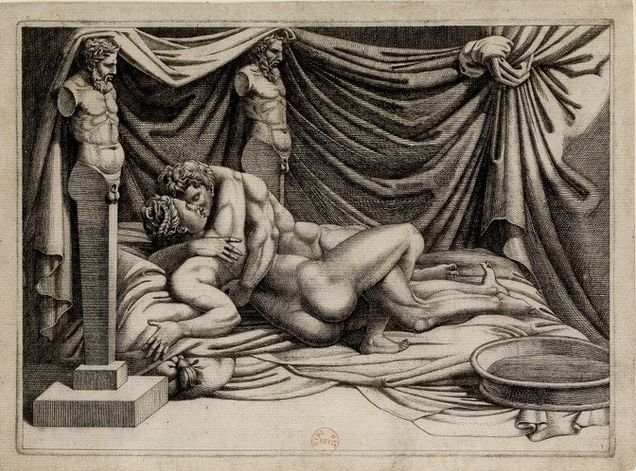
In I modi’s printed reproductions, the series’ sexually explicit imagery is unmediated as it moves from the private elite sphere of individual drawings to the more public arena of circulated prints. In doing so, I modi transforms from a commissioned series of finished drawings by a renowned artist into scandalous, decontextualized reproductions by landing in the hands of what David Freedberg calls the “vulgas”; I modi became consumable by the masses.17 The already sexualized bodies are rendered objects charged with the ability to elicit natural, yet dangerous responses from the images’ viewers. In this respect, the body as a site for censorship serves as a mechanism of social and sexual control.
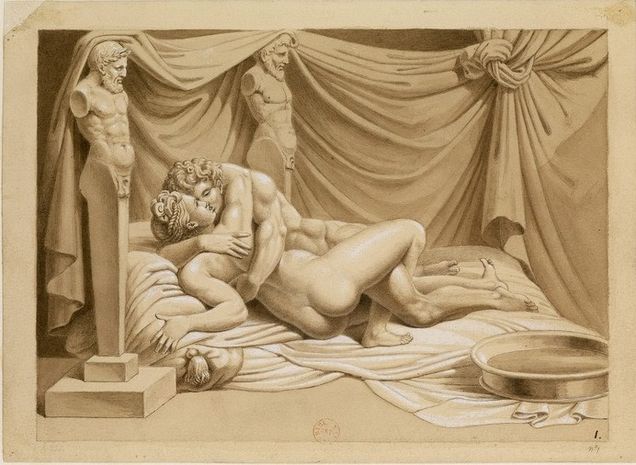
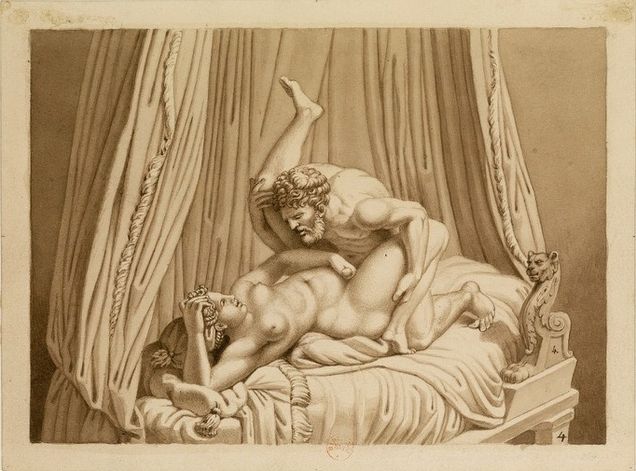
Though Romano’s originals no longer survive, copies in the form of prints and drawings have endured.18 Now housed at the Bibliothèque Nationale de France (BNF), the Paris Position is a nineteenth-century hand-drawn replica of Position 1, the first in the original series by Romano (figs. 1 and 2).19 The Paris Position was originally drawn and owned by French antiquarian, Jean-Frédéric Maximilien de Waldeck.20 Waldeck not only drew the Paris Position but illustrated twenty wash drawings of I modi (fig. 3).21 Now, both are kept together at the BNF with a preface by Waldeck. In a Vasarian manner, Waldeck provides a history of the I modi scandal and his interest in the series. The Paris Position portrays a heterosexual couple embracing on a bed of sheets. The woman lies on her side, displaying her back as she holds her lover with her right arm and grasps the sheets with her left. Her breasts, genitalia, and the penetrative act are hidden, which are features that do not seem incidental when considering the print's survival. Rather than the sexual act itself, the formal emphasis is placed on the visual entanglement of limbs. Additionally, the woman recalls the docile, reclining nude popularized in sixteenth-century paintings, which provides a contrast to the active women in the other I modi prints (figs. 4-6).22 For a series that has only narrowly survived iconoclastic efforts, it is not by accident that the position with the least amount of sexual exhibitionism has survived in more than one example.
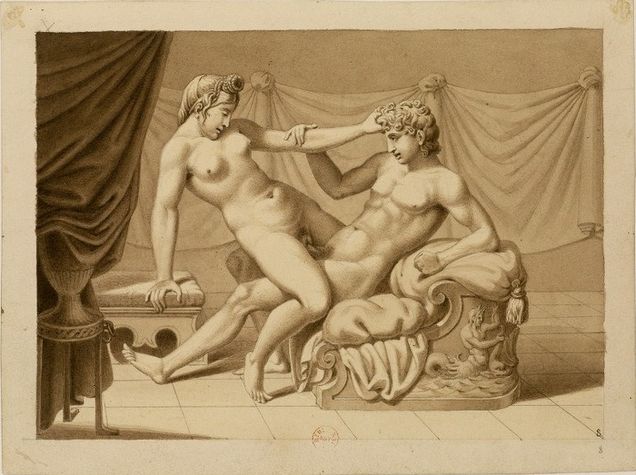
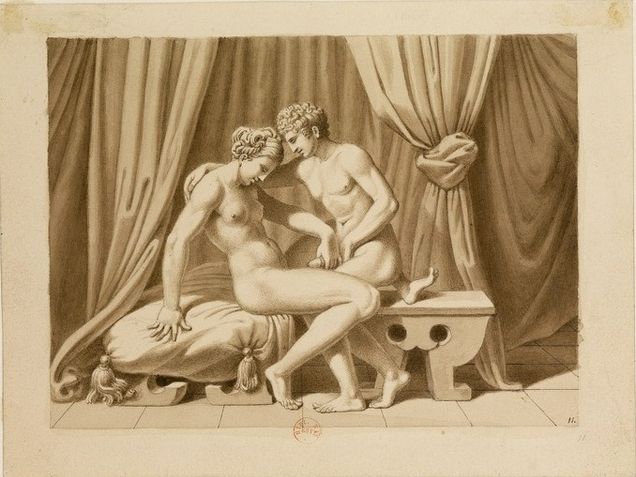
With sexual intercourse hidden, the observer of the Paris Position is prompted to fill in the blanks. The suggestion of penetration enhances its arousing aspect, thereby eliciting an imaginative engagement by the implied heterosexual male viewer. This type of viewer participation is even more explicit in I modi’s afterlife. The British Museum’s set of nine fragments has been reduced to torsos, heads, and limbs (fig. 7). Their treatment is decidedly violent. In their seemingly inoffensive states, the fragments only accentuate their erotic potential. Like the Paris Position, to engage with the fragments is to imagine their missing actions. Drawing upon Freedberg’s theory of viewer reception in The Power of Images, the “borderline” quality of the images is what elicits arousal.23 In this regard, the “borderline” of what art is drives its erotic potential; tension is what renders I modi illicit. Ultimately, it is the censorship of I modi which attempted to quell the sexual response that drove its eroticism. The series’ heightened intrigue is attested to by its survival as collected objects, even in fragmented form.

In the Paris Position, the couple is flanked by two herms, whose inclusion conveys the Renaissance adoption of a classical precedent and hints at a broader sexualized Ovidian allusion.24 The herms function not just as furnishings that support the drapery and frame the image, but they also act as witnesses to the sexual events unfolding before them. They are placeholders for the external viewers and function as second eyes through which the viewer engages with the sexual act. In this mirrored gaze, the intended heterosexual male viewer is implicated, allowing for a virtual, yet controlled, engagement with the couple as tangible figures. In applying Freedberg’s framework, the herms become enlivened participants in their voyeuristic attentiveness to the couple, thereby bringing attention to the relationship between looking, enlivening, and erotica that permeates the Paris Position.
Like sculpture, the affordance of both print media and drawings are their tactility. Within a controlled environment, the original I modi drawings would have been stored away from prying eyes, held in albums, only to be engaged with through the hands of an elite collector and in the company of peers educated in how to “correctly” interpret its imagery. Kept in albums, there is an aura of concealment; the images are “clothed” in their aristocratic context. In this manner, engaging with the drawings would have been an act of unclothing, though permissible for elite viewers. This engagement becomes problematic once the singular drawings are circulated in printed reproduction. Prints are ostensibly two-dimensional, but to engage with prints is to collect, hold, and possess them in a tactile manner. Like Pygmalion, the viewer-as-handler imbues life into the figures and their sexual exploits. Enacting this Pygmalion-like fantasy through an imaginative engagement, the figures become real fleshy beings that can be physically touched, engaged with, and possessed. Thus, the entire viewing experience of I modi is multisensory; the figures in the prints encourage real and imagined tactile responses, much like the sculptural herms. Ultimately, through this tactile engagement, the print and its figures are transformed into objects the viewer can possess.25
The real and imagined possession of I modi would have therefore elicited arousal and potentially sinful responses. This was exacerbated when Pietro Aretino paired Raimondi’s prints with sexually explicit sonnets in 1526.26 In Position I’s sonnet, Aretino provides both a male and female voice, perhaps to widen the intended implicit viewership to include women (fig. 8).27 Nevertheless, Aretino’s female character vocalizes her desire, which grants her a form of agency that would be antithetical to contemporary attitudes concerning women’s ‘proper’ behavior—attitudes that upheld the virtues of silence. Consequently, Aretino’s text encourages the viewer’s engagement with the print as an enlivened image that now speaks, which further places the series in the profane realm, thereby resulting in its censorship.28
I modi was the first instance of a series of unveiled, explicitly sexual imagery circulated in print throughout Renaissance Italy.29 The entire program was novel; from its subject matter to its material form, both aspects played a role in I modi’s censorship. I modi exemplifies the anxieties that images of the sexualized body presented and the dangers of the implicit responses to it by both the elite and non-elite viewers. The printed reproductions of I modi operated within a contemporary discourse of sexuality, the dangers of the senses, and their necessary control.
____________________
Appendix
|
Sonetto I Fottiamci, anima mia, fottiamci presto E se post mortem fotter fosse honesto, — Veramente egli è ver, che se i furfanti Ma lasciam'ir le ciance, e sino al core e se possibil fore, |
| Translation
“Let's make love, my beloved, let's make love right away since we are all born for this. And if you adore my cock, I love your pussy; and the world wouldn't be worth a fuck without this. And if it were decent to screw postmortem I would say: Let's screw so much that we die of it, and in the beyond we'll fuck Adam and Eve, who found death so indecent.” “It is really true that if the scoundrels had not eaten that traitorous fruit, I know that lovers would be able to content themselves fully. But let's stop the chitchat and stick your cock into me up to my heart, and do it so that there my spirit bursts, which on a cock now comes alive, now dies. And if it is possible, don't keep your balls outside of my pussy, witnesses of every fucking pleasure?” |
Pietro Aretino, “Sonnet I.” In Les sonnets luxurieux du divin Pietro Aretino, 1526. Bibliothèque Nationale de France.
Translation by Bette Talvacchia, Taking Positions: On the Erotic in Renaissance Culture (Princeton: Princeton University Press, 1999), 199.
____________________
Iakoiehwahtha Patton approaches her scholarship on the Northern Renaissance at the intersection of gender, colonialism, and artistic representations. She completed her BA at the University of Toronto where she was the President of the History of Art Students’ Association and wrote on land, coloniality, and their manifestations in art. Now an MSt student at Oxford, Iako focuses on the gendering of death in the funerary arts of Renaissance France.
____________________
1. Jill Burke, “Nudity, Art, and the Viewer,” in The Italian Renaissance Nude (New Haven: Yale University Press, 2018), 70.
2. Burke, “Nudity, Art, and the Viewer,” 69-70.
3. In the Italian Renaissance, the erotic nude emphasized the sensual nature of the body, often veering into the pornographic. As such, these depictions were generally confined to elite circles and their private collections. Not every nude in the Renaissance was erotic; in fact many works of classical or religious themes included nude subjects. Nevertheless, the common thread linking the nude and the erotic nude during the Renaissance was the overarching humanist interest with the human form in art. Sara F. Matthews-Grieco, “Satyrs and sausages: erotic strategies and the print market in Cinquecento Italy,” in Erotic Cultures of Renaissance Italy (Abingdon: Routledge, 2010), 20.
4. Bette Talvacchia, “The Historical Situation,” in Taking Positions: On the Erotic in Renaissance Culture (Princeton: Princeton University Press, 1999), 5.
5. Bette Talvacchia, “Introduction,” in Taking Positions: On the Erotic in Renaissance Culture, (Princeton: Princeton University Press, 1999), ix.
6. See Talvacchia, Matthews-Grieco, and James Grantham Turner, “Marcantonio’s Lost Modi and Their Copies,” Print Quarterly 21, no. 4 (2004): 363–84.
7. Talvacchia, “The Historical Situation,” 4.
8. Talvacchia, 4.
9. Talvacchia, 6.
10. Further study may consider how our understanding of I modi would change depending on the intentions of Giulio Romano and his patron.
11. Around 1524, Pope Clement VII became involved in an effort to regulate artistic production and printed material, especially those deemed indecent. As a result, Marcantonio was briefly imprisoned for his production of I modi in print format. Giorgio Vasari, Lives of the most eminent painters, sculptors & architects, volume 6 (London: Macmillan, 1912-15), 103; Talvacchia, “The Historical Situation,” 6.
12. Talvacchia, 4.
13. Talvacchia, 7.
14. Talvacchia, 6; Vasari, Lives, 105.
15. Matthews-Grieco, “Satyrs and sausages,” 19.
16. Matthews-Grieco, “Satyrs and sausages,” 21.
17. David Freedberg, “The Senses and Censorship,” in The Power of Images: Studies in the History & Theory of Response (Chicago: University of Chicago Press, 1989), 361.
18. Talvacchia (xi-xii) posits that the drawings were most likely for elite collectors, which have not been located. Despite the fact that the first edition engravings no longer survive due to their confiscation and heavy censorship, early modern collecting practices and appetite for the erotic have secured I modi’s afterlife.
19. The Paris Position is compositionally similar to the London Position and Vienna woodcut in showing Position 1. Unfortunately, the Vienna woodcut has been lost. However, the London Position has been attributed to Agostino Veneziano and, as James Grantham Turner (2004) has argued, is likely the source for I modi’s later copies, including, perhaps, the Paris Position. Therefore, the Paris Position likely provides insight into what the original engravings after the Romano drawing looked like.
20. Mary Rebecca Darby Smith and Henry Hopkins, Recollections of Two Distinguished Persons: La Marquise de Boissy and the Count de Waldeck (Philadelphia: J.B. Lippincott, 1878), 60, 66.
21. James Grantham Turner, “Marcantonio’s Lost Modi and Their Copies,” Print Quarterly 21, no. 4 (2004): 363-366.
22. An important example of the reclining nude is the Venus of Urbino by Titian (1534) including its numerous variations.
23. Freedberg, “The Senses and Censorship,” 355-356.
24. In Book 10 of Metamorphoses, Ovid recalls the tale of Pygmalion, the sculptor who carved his ideal maiden from ivory. After praying to the gods for a wife as beautiful as his creation, Pygmalion’s sculpture is brought to life by Venus. The poem describes Pygmalion’s relations with the ivory figure as erotically tactile: he touches, kisses, strokes, and “[feels] the ivory soften / under his fingers.” As a medium, sculpture is profoundly tactile and the reception of sculpture rests upon its engagement as a spatial object. With its poetic underpinnings in ancient texts, touch is emphasized by early modern Italian writers as an essential component of sculpture’s appreciation. The prints’ intended viewers would have been familiar with both the sacred and profane handling of sculpture, from those collected in the studiolo to movable religious icons. In this way, the herms elicit a tactile response in the viewer, becoming enlivened figures through their visual engagement as sculptured beings. J. D. Reed, “Book 10,” in Ovid: Metamorphoses, translated by Rolfe Humphries (Indiana: Indiana University Press, 2018), 243 (line 286-287).
25. Freedberg, “The Senses and Censorship,” 353.
26. Pietro Aretino. “Sonnet I,” in Les sonnets luxurieux du divin Pietro Aretino, 1526. Bibliothèque Nationale de France; See appendix for sonnet and translation.
27. Aretino’s sonnets would have provided a rare opportunity for women to view images depicting female sexual agency and desire alongside poetry with similar themes. The illustrated sonnets would have represented a departure from more traditional depictions of passive women experiencing sexual encounters, and thus may have encouraged Renaissance women to explore and articulate their own desires.
28. Freedberg, “The Senses and Censorship,” 350-353.
29. Talvacchia, “Introduction,” xi.
Notes About Contributors
Toni Armstrong is a PhD candidate in the History of Art and Architecture at Boston University. Toni works on 19th- and 20th-century art in the United States, with a particular focus on women art collectors, queer and women’s history, and alternative museum practices.
Miray Eroglu is a first-year PhD student in Art History at Temple University's Tyler School of Art and Architecture concentrating on Ottoman Art. Miray holds an MA from New York University’s Institute of Fine Arts and a BA Honors in Art History from McGill University.
Corey Loftus is a PhD student at the Institute of Fine Arts focusing on surrealist art in Europe and the Americas. She received her MA from Tufts University and her BA from the University of Pennsylvania.
Liz Neill is an archaeologist, museum professional, and fifth-year PhD Candidate at Boston University specializing in ancient art and provenance. Her dissertation investigates different “species” of imagined creatures on Archaic vases and how their geographies, ancient and modern, shape our perceptions of the ancient world.
Iakoiehwahtha Patton approaches her scholarship on the Northern Renaissance at the intersection of gender, colonialism, and artistic representations. She completed her BA at the University of Toronto where she was the President of the History of Art Students’ Association and wrote on land, coloniality, and their manifestations in art. Now an MSt student at Oxford, Iako focuses on the gendering of death in the funerary arts of Renaissance France.
Gilda Posada is a Xicana art historian, artist, and curator from Southeast Los Angeles. She received her AB from UC Davis and her MFA and MA in Visual and Critical Studies from California College of the Arts. Currently, Gilda is a PhD candidate in History of Art at Cornell University.
Shawn C. Simmons is a PhD student in the History of Art and Architecture at the University of Pittsburgh, where he studies queer theory and ecology in American art after 1945.
Danielle Wirsansky is a passionate theater artist, director, and writer. With a background in dramatic literature and performance, she thrives on creating thought-provoking narratives to be used as public history. Danielle is a PhD Candidate in History at Florida State University and the Finance Director at White Mouse Theatre Productions.
The Secrets We Keep
by Danielle Wirsansky
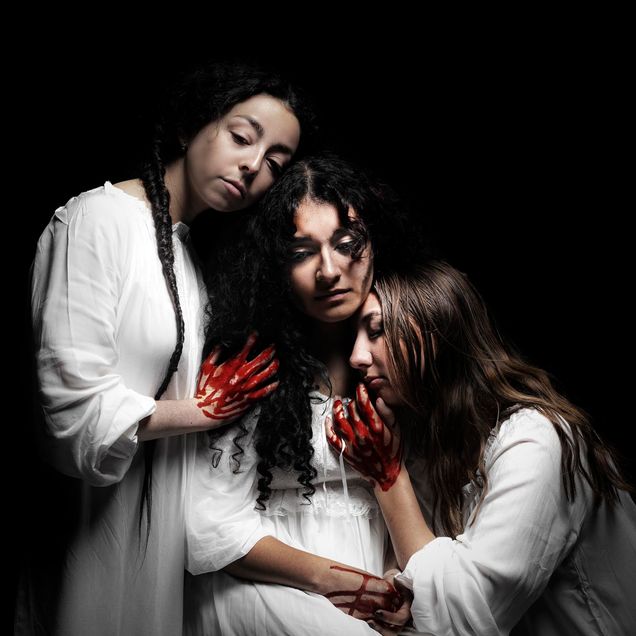
The Secrets We Keep is a new musical that immerses audiences in the mystical realm of rusalki, using folklore to explore sensitive historical themes and reveal hidden truths. The story follows Luba, a Jewish Polish woman tragically transformed into a rusalka— an undead, enchanting water spirit both alluring and eerie—during the Holocaust, as she seeks revenge and grapples with complex moral dilemmas such as revenge, justice, and redemption. Through the rusalki’s journey, the musical navigates themes of vengeance, humanity, and forgiveness, shedding light on silenced voices from the past and fostering empathy through the intertwining of folklore and historical narratives.
The Secrets We Keep confronts contemporary secrets surrounding the Holocaust, especially those perpetuated by the Polish government. The musical unravels the consequences of legislated silence about Poland's involvement in anti-Semitic acts during World War II. The Polish law is commonly referred to as the “Polish Holocaust Law” or “Polish Anti-Defamation Law” and was passed in 2018 to restrict discussion of Poland’s involvement in the Holocaust. It specifically criminalizes accusations of Polish complicity in Nazi war crimes. Neighbors: The Destruction of the Jewish Community in Jedwabne, Poland by historian Jan T. Gross serves as a historical touchstone that deeply informs the narrative of The Secrets We Keep. Gross details the harrowing events of the Jedwabne pogrom, in which Polish villagers brutally murdered their Jewish neighbors during World War II.1 This historical event underscores the complex dynamics between Jewish and non-Jewish communities during the Holocaust and reveals the depths of human cruelty through the betrayal of trust.
Similarly, The Secrets We Keep delves into the intersecting experiences of Jewish and non-Jewish individuals and creates a poignant parallel to the themes explored in Gross’s seminal work. Meanwhile, Poland has refused to take accountability for the actions of their own citizens. The rusalki help us to critique the suppression of historical truths and the consequences of silence through imagery and song.

This project is not merely a musical, but a form of public history. Developed through the Elie Wiesel Social Action Fellowship, The Secrets We Keep is dedicated to Holocaust education and combating anti-Semitism. The musical serves as a catalyst for community engagement and learning. This approach, which combines history, folklore, music, and performance, allows the creative team to reach diverse audiences and foster critical discussions about the past.
I began intensive research for the musical in summer 2023, followed by a virtual reading that August. I collaborated with composer Frank Sanchez to cultivate the sound of the music, which we wanted to be modern, cinematic, and yet still reflective of the Slavic influences of the region where the story is set. A successful public workshop concert was held at Common Ground Books in October 2023, featuring a talkback session for audience feedback. Rehearsals began in December 2023, leading up to our production at Florida State University in Tallahassee in April 2024. Shannon Wolf and Jane Achenbach, the production’s Music Directors, also added significant contributions to the show’s musical compositions as the process progressed.
The development process involved research into Slavic folklore on the rusalka figure. This includes regions such as Russia, Ukraine, Belarus, Poland, Slovakia, the Czech Republic, and other Slavic-speaking areas. Rusalki are particularly prevalent in Eastern European folklore and mythology.2 These mystical beings are believed to inhabit bodies of water such as rivers, lakes, and ponds and are typically portrayed as beautiful maidens with long, flowing hair, who possess the ability to both mesmerize and terrify those who encounter them.
The rusalki's significance extends beyond mere folklore and resonates deeply within Slavic culture. They are often associated with nature, fertility, and the cycle of life and death. In traditional Slavic beliefs, the rusalki were thought to be the spirits of young women who had died untimely deaths, particularly those who perished by drowning. As such, they were both revered and feared. As such, various rituals and customs were developed to appease and protect against their influence.3 The story follows Luba, a young Jewish woman tragically killed in a pogrom in her village during the Holocaust. Luba is transformed into a rusalka, who, generations later, discovers an unexpected chance for revenge when she befriends a young woman who unknowingly carries the bloodline of her murderer. While not explicitly featured in Jewish folklore, the rusalka's presence in The Secrets We Keep serves as a bridge between Slavic and Jewish traditions, thereby embodying the fluidity and interconnectedness of cultural narratives as well as government-determined divisions between peoples and their artificiality.

Drawing from historical accounts, I explored the nuances of the Holocaust, uncovering both documented events and overlooked narratives. The Secrets We Keep sheds light on the often-neglected experiences of LGBTQ+ individuals during this dark period, addressing their persecution, discrimination, and resilience. Grounded in thorough research, the musical confronts the historical erasure of queer victims and challenges prevailing narratives. Luba, though targeted and attacked for being Jewish, receives particularly harsh treatment because she is queer. Gad Beck, a Jewish resistance fighter who documented his experiences in An Underground Life: Memoirs of a Gay Jew in Nazi Berlin,4 and another chronicle Aimee and Jaguar: A Love Story, Berlin 1943, which tells the true story of the love affair between a German housewife and a Jewish woman who was part of the underground resistance in Berlin during World War II, both provide authentic insights into the diverse experiences of queer individuals during the Holocaust.5 By weaving together past and present, the musical amplifies the voices of queer victims, ensuring that their stories are not forgotten and granting them a platform for their experiences to be acknowledged and honored.
As the musical approaches its world premiere at the Lab Theatre at Florida State University from April 25th to 27th, each stage of development is guided by a commitment to historical accuracy, cultural sensitivity, and a profound dedication to deepening our understanding of the past. Collaborating with the Holocaust Education Resource Council and Congregation Shomrei Torah, we are organizing a lobby exhibit and post-show talkbacks to underscore the historical context of the production, demonstrating our engagement with communities and dedication to Holocaust education and combating of anti-Semitism.
The ultimate destination for The Secrets We Keep is a weeklong Off-Broadway residency at the esteemed American Theatre of Actors in New York City from May 23rd-26th, 2024. This opportunity will amplify the musical’s reach, allowing it to contribute to broader conversations about historical memory, the Holocaust, and the transformative power of storytelling in a global context.
As a scholar committed to public history, my aim is to leverage the emotional resonance of the rusalki mythos to create a space for dialogue and understanding. By embracing folklore as a conduit for historical narratives, I hope to contribute to broader conversations about memory, silence, and the role of the arts in public history. Through The Secrets We Keep, I strive to illuminate the shadows of history, one haunting melody at a time.
____________________
Danielle Wirsansky is a passionate theater artist, director, and writer. With a background in dramatic literature and performance, she thrives on creating thought-provoking narratives to be used as public history. Danielle is a PhD Candidate at Florida State University and the Finance Director at White Mouse Theatre Productions.
____________________
1. Jan T. Gross, Neighbors: The Destruction of the Jewish Community in Jedwabne, Poland (Princeton: Princeton University Press, 2022), 7.
2. Linda J. Ivanits, Russian Folk Belief (Milton Park, Abingdon: Taylor & Francis, 2015), 76.
3. Ivanits, Russian Folk Belief, 80.
4. Gad Beck, An Underground Life: Memoirs of a Gay Jew in Nazi Berlin (Madison: University of Wisconsin Press, 1999), 148.
5. Erica Fischer, Aimee & Jaguar: A Love Story, Berlin 1943 (New York: HarperCollins, 2016), 12.
Dragging Away: Queer Abstraction in Contemporary Art
by Shawn Simmons
LEX MORGAN LANCASTER
Dragging Away: Queer Abstraction in Contemporary Art
Durham: Duke University Press, 2022. 208 pp; 35 illust., incl. 16 page color insert
$24.95 paperback
978-1-4780-1867-4
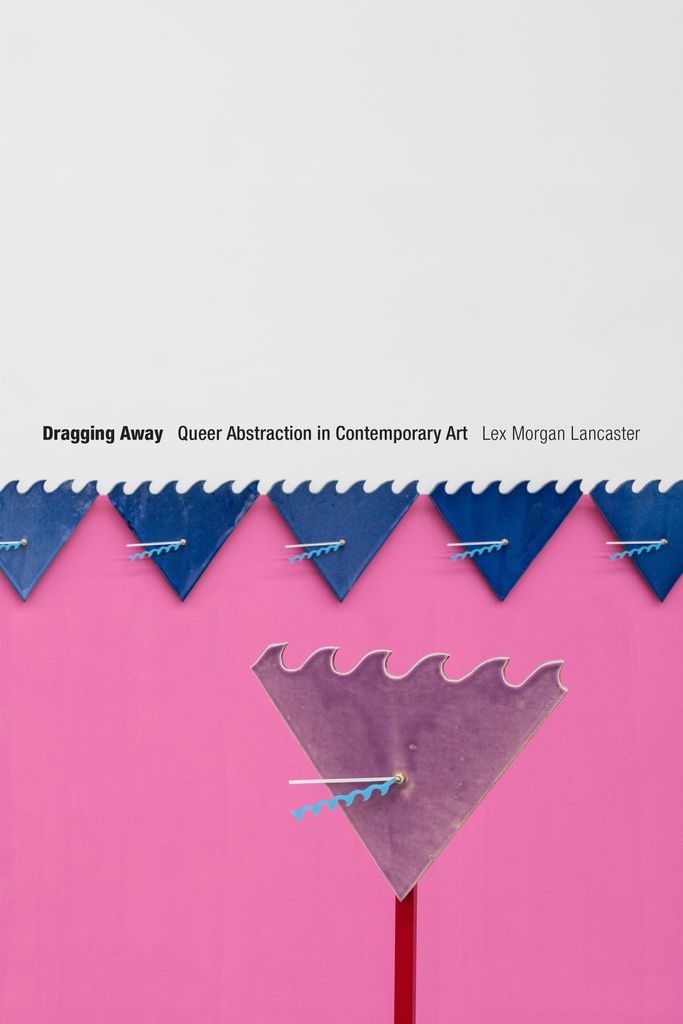
In a review of the Des Moines Art Center’s 2019 exhibition Queer Abstraction, Lex Morgan Lancaster pointed out the difficulty of a central term: “‘queer abstraction’ may seem a contradiction in terms, since direct representation and visibility have been so central to queer politics and the ongoing battle for LGBTQ rights and recognition in the public sphere. We have come to expect a politically viable queer art to include overt imagery of queer bodies, communities, erotics.”1 Despite this apparent contradiction, Lancaster understands queer abstraction as a mode of expression that disrupts representational conventions of gender and sexuality. Encompassing a range of visual practices, queer abstraction can evoke complex and fluid experiences of desire, embodiment, and subjectivity.
Where, then, does queer abstraction find its place in art history? In Dragging Away: Queer Abstraction in Contemporary Art, Lancaster explores this question, offering fresh insights into the transformative power of abstraction to reject normative conceptions of identity, destabilize fixed categories, and reimagine possibilities for self-expression and social critique. Building on the scholarship of queer theorists and art historians alike, Lancaster posits that abstraction is never a neutral gesture. In Lancaster’s compelling analysis, “queering” acts as a “force or vector that works beyond particular bodies” and ultimately allows abstract artists to resist erasure and reject fixed interpretations of identity (14). Throughout the book, “drag” and “dragging” are processes that “exert a destabilizing pull on us as viewers” (3). Drawn from Elizabeth Freeman’s term “temporal drag” and the queer mode of performance, Lancaster’s focus on drag reframes and challenges artistic conventions, ultimately inviting a more reparative reading of abstraction as a tool for queer resistance through its emphasis on materiality over visibility.2
Much of Dragging Away grapples with the ambiguity of the term “queer” itself. The author focuses on each artist’s contribution to gender and sexuality politics through queering. Lancaster’s interdisciplinary approach draws from visual, queer, feminist, Black, and disability studies, demonstrating the emancipatory potential of abstraction to challenge disciplinary boundaries. Constantly questioning the division between formal and social concerns across four thematic chapters, Lancaster examines the ways in which artists manipulate formal elements such as geometry, color, and materiality to disrupt the representational frameworks of queer art and allow for new modes of perception. This nuanced approach explores the intersections of identity, representation, and artistic practice. Lancaster’s use of “queer formalism,” as coined by Jennifer Doyle and David Getsy, emphasizes close visual analysis while considering how gender, sexuality, and desire operate beyond formal depictions.3 Lancaster uses this methodological framework to uncover layers of meaning within artworks that extend beyond their surfaces. Several of the author’s contemporary case studies are placed in contact with canonical twentieth century abstract works in order to examine how these artists have reinterpreted and subverted the exclusionary tendencies of modernism.
In chapter one, Lancaster considers the use of hard-edge geometric forms in contemporary artwork by Nancy Brooks Brody, Every Ocean Hughes, and Ulrike Müller. Placing these examples in opposition to modernist works by Ellsworth Kelly and László Moholy-Nagy, Lancaster reinterprets the hard-edge line as a queer visual tactic, a site of activation that “gives way to a transitory process of edging that unfixes and exceeds containment” (39). This temporal drag extends into the second chapter, “Feeling the Grid,” in which Lancaster juxtaposes Lorna Simpson’s Public Sex series with Agnes Martin’s grid paintings. In Simpson’s photo-based felt installations, the grid acts as a vector for various forms of queer relationality. Lancaster notes how the “queer alchemy” of the grid allows for a certain flexibility, creating a “space for intimacies to exceed bounds of difference, of public and private, of historicizing coordinates of here and now or then and there” (80). In chapter three, Lancaster turns to the significance of vibrant color in work by Linda Besemer, Lynda Benglis, and Carrie Yamaoka, arguing that the queer potential of color appears in these works “as both a material and an optical element that performs affectively rather than representationally” (89). The final chapter examines spatial and material elements of installations by Sheila Pepe, Harmony Hammond, Shinique Smith, and Tiona Nekkia McClodden, arguing that these artists adopt the processes of unraveling, ripping, and cutting to deform and destabilize notions of material coherence. The book concludes with a short epilogue in which Lancaster critically considers the symbolic evolution of the rainbow pride flag since 1978, offering a reflective lens through which to assess the broader implications of queer abstraction explored throughout the text.
While Dragging Away offers noteworthy contributions to several disciplines, Lancaster’s foregrounding in art history holds significant implications for the field. In challenging prevailing narratives that prioritize the depiction of bodies or explicit eroticism in queer art, Lancaster shifts our attention to queering as a strategic method for resisting fixed categories of identity. This approach may interest readers beyond academic circles, attracting anyone interested in contemporary art, queer studies, or cultural theory. Occasionally, the analysis is impeded by the inherent challenges of translating abstract visuals into language; the author reflects on this in the third chapter, noting that the “difficulty of putting our experience of color into words constantly reminds us of the limits of linguistic expression” (89). However, the considerable number of images allows readers to contextualize and engage in their own visual analysis. While the book is scholarly in its theoretical approach and analyses, the extensively illustrated text is accessible and engaging for general readers with an interest in its interdisciplinary material. A timely addition to the broader discourse on the (in)visibility of identity in contemporary art, Dragging Away invites us to reconsider the roles queerness can play in embodiment and representation—and in art at large.
____________________
Shawn C. Simmons is a PhD student in the History of Art and Architecture at the University of Pittsburgh, where he studies queer theory and ecology in American art after 1945.
____________________
1. Lex Morgan Lancaster, “Queer Abstraction,” ASAP/J, July 16, 2019. https://asapjournal.com/review/queer-abstraction-lex-morgan-lancaster/.
2. For further discussion of the term “temporal drag” see Elizabeth Freeman, “Deep Lez: Temporal Drag and the Specters of Feminism,” in Time Binds: Queer Temporalities, Queer Histories (Duke University Press, 2010), 59–94.
3. See Jennifer Doyle and David Getsy, “Queer Formalisms: Jennifer Doyle and David Getsy in Conversation,” Art Journal 72 (August 5, 2014): 58–71.
The Provenance Reliability Index
by Liz Neill
Provenance: literally, where something comes from. Once considered secondary to the aesthetic value of an artwork or a secret to be hidden in restricted files, object histories have become more widely discussed by archaeologists and art historians in recent decades. Major US museums, such as the Museum of Fine Arts, Boston and the San Antonio Museum of Art, have hired staff to ensure their collections are up to date. Every museum object has its own history. Cultural heritage experts, archaeologists, and politicians worked together to author the 1970 UNESCO Convention, which created the current professional standard for ancient art: any antiquities being sold, imported, or exported to countries that have ratified the Convention must have object histories dating back to 1970 to be considered licit. However, a pre-1970 record is a binary checkbox that glosses over the earlier origin and acquisition histories. Centuries of the antiquities trade have left scholars with intermediate shades of gray. This ambiguity in the dataset is both a limitation and an opportunity: the wide range of geographical data offers more ways to analyze, preserve, and exhibit ancient art while acknowledging the complex history of the field.
In my dissertation, “Ancient Travels, Modern Geographies: Provenance(s) of Imagined Creatures on Archaic Painted Pottery (660-480 BCE),” I analyze where and how different “species” of creatures painted on pots were moved around the ancient Mediterranean and modern worlds, and the impact of these movements on our understanding of Archaic iconographies. In order to analyze these ancient and modern movements, scholars and curators need a system that works with degrees of provenance. I have developed the Provenance Reliability Index for my own research and for others who study moveable material culture.
Readers may be familiar with “tombstone” information often found on museum labels, which includes an object’s creation date, artist or workshop, style, material, and possibly its place of creation: all information about the beginning of an object’s ancient life. An object’s field context refers to the end of its ancient life. This includes where and in what type of use-context an object was found (i.e. grave, house, workshop, sanctuary, etc.), which objects were found together in that context, and the context’s approximate use date. This information is particularly crucial for moveable material culture (including pottery) because ancient trade networks often resulted in the movement of objects far from their origin point.
The Index highlights a range of provenance reliability across five categories. Category One objects have been excavated scientifically and have a publicly known field context. Category Two objects may have a deposition site, but no exact context (i.e. from the necropolis at Vulci but does not have an associated tomb assemblage). These objects mostly were excavated in the eighteenth and nineteenth centuries, before the now-standard practice of documenting field context was a priority. Category Three is the most sparse and contains objects demonstrated to come from a looted context. Category Four contains objects with second- or third-hand findspots from dealers, collectors, or indirect historical sources which may or may not be accurate (i.e. “Central Italy (?)” or “said to be from Athens”). Lastly, Category Five includes objects that have no findspot information. While it is possible to somewhat contextualize these objects based on their style, there is no replacement for knowing an object’s field context.
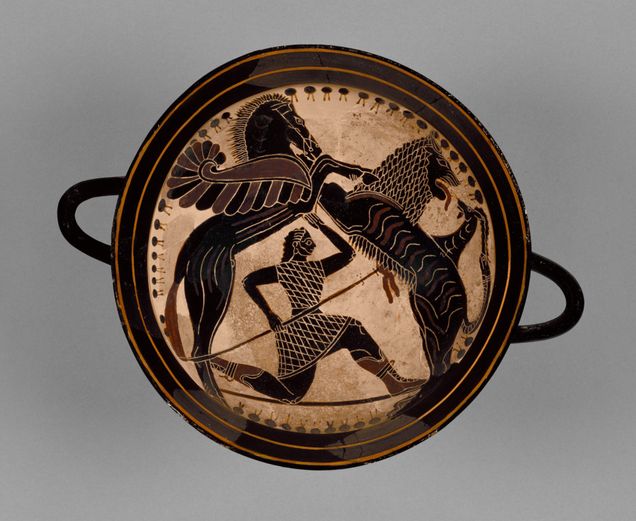
The following objects illustrate the range of contexts across the Index’s five categories. For example, the rim of an Attic dinos (large decorated container) excavated from a bothros (votive well) at the sanctuary of Aeolus on the island of Lipari would belong to Category 1 (Lipari 19000). A Caeretan hydria (water vessel) known to come from a necropolis at Cerveteri (Caere), without further context, would belong to Category 2 (Villa Giulia 50649). An Attic lekythos (oil vessel) recently repatriated from the San Antonio Museum of Art to Italy would belong to Category 3 (DEAC.91.80.1). A Corinthian aryballos (oil vessel) said to be from Thebes and purchased in Athens by an agent of the Museum of Fine Arts, Boston would belong to Category 4 (MFA 95.1). Lastly, a Laconian kylix with no findspot would belong to Category 5 (Getty 85.AE.121.1).
The “creature pot corpus” is a useful first dataset to demonstrate the Provenance Reliability Index because the corpus has a good distribution across the categories, creatures were painted on a range of ceramics from various production sites, and “monsters” appeal to a wide audience and have circulated across both the ancient and modern worlds. This index is meant to be easily usable and repurposable. The categories within the index can apply to other types of art that were removed from their places of origin since the eighteenth century, such as Roman portrait busts or Benin bronzes.
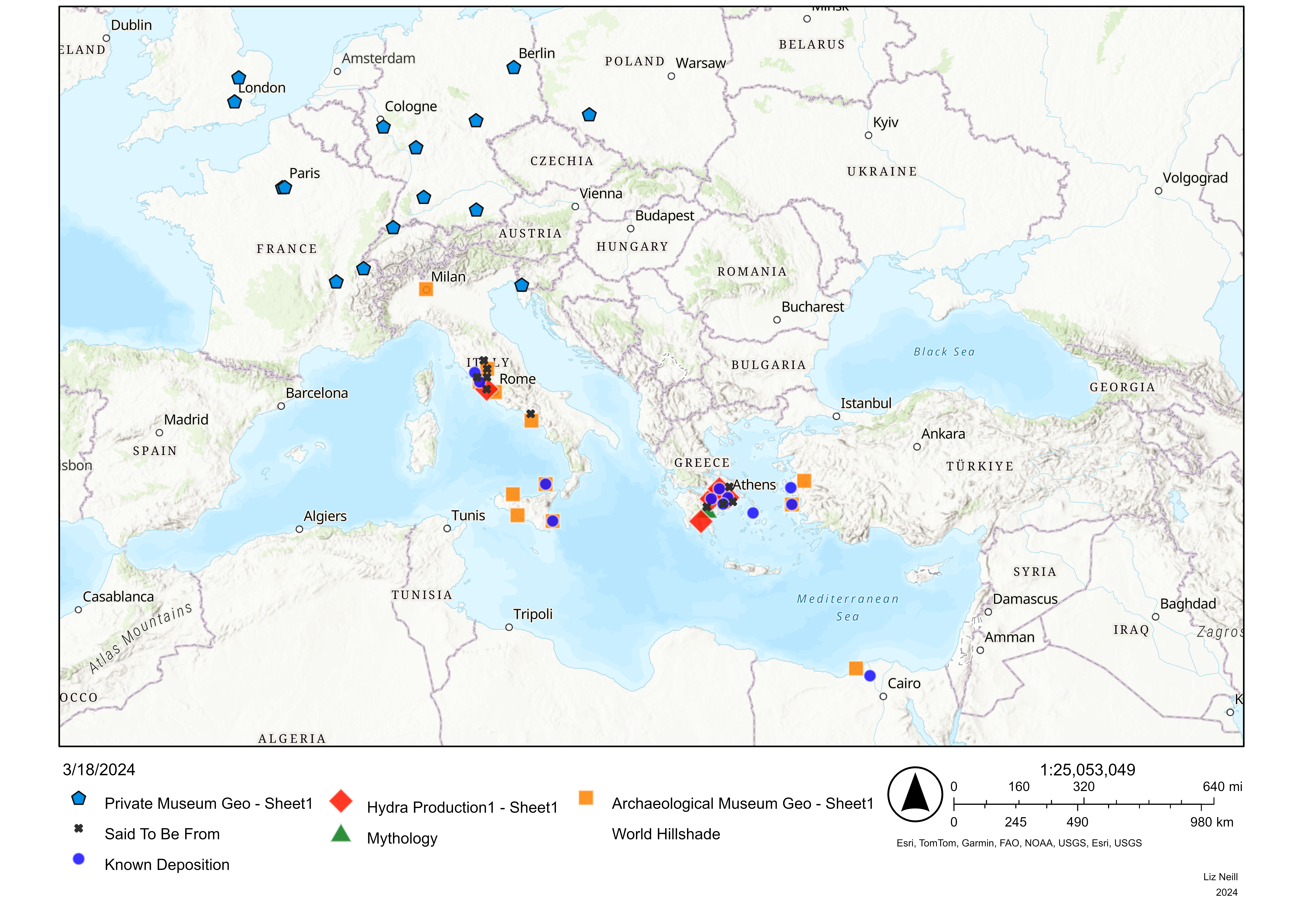
What does it mean to juxtapose ancient and modern geographies? Often, on museum labels, visitors see only a stylistically-identified production site from the beginning of an object’s ancient life, one point on a much longer timeline that extends through today. In contrast, Figure 2 showcases six different geographies of Hydra ceramics across both the ancient world and the modern world: the mythological location of the Hydra at Lerna (as described by ancient poet Hesiod) (green triangle), production sites in Greece and Etruria (red diamond), known find spots around the Mediterranean (blue circle), “said to be from” findspots (black x), regional relocations of objects to archaeological museums (orange square), and the constellation of objects removed to western Europe and the United States (light blue pentagon).
This corpus provides a wealth of data that can be reinterpreted and represented in many ways: art historical scholars can study the diachronic evolutions and movements of a single creature, archaeologists can study the trade and comparative distributions of vase shapes, styles, and types in the Archaic period, and curators can contextualize their collections within the full universe of imagined creatures on painted pottery across the Mediterranean. Most importantly, this project addresses the urgent issue of ethically interpreting pre-1970 objects that have unclear or no provenance. My dissertation confronts the reality that the majority of ancient Mediterranean painted pottery has been permanently divorced from its original field context and offers one path forward. Ideally, this new dataset, alongside the digital text of my dissertation, will promote discussions of provenance, trade routes, the development of black-figure style, charting the development of antiquities collections, and many more avenues of research.
____________________
Liz Neill is an archaeologist, museum professional, and fifth-year PhD Candidate at Boston University specializing in ancient art and provenance. Her dissertation investigates different “species” of imagined creatures on Archaic vases and how their geographies, ancient and modern, shape our perceptions of the ancient world.
Notes about Contributors
Sakina Ahmad is a communications professional with an MA in Art and Museum Studies from Georgetown University. She excels in marketing for artists and cultural institutions, merging design and writing to create meaningful content. Currently, she is the Assistant Manager of Marketing and Content at the American Alliance of Museums.
Tracey Davison is A PhD candidate in Medieval Studies at the CMS, York. Her thesis addresses the absence of a body of scholarship devoted to the use and perception of textiles and clothing in Anglo-Saxon England, examining the degree to which the art historical and archaeological evidence for early medieval textiles, clothing and adornment can be woven into and supported by the literature (vernacular and Latin, secular and ecclesiastical) produced and circulating in Anglo-Saxon England.
Isabella Dobson is a second year PhD student in the History of Art and Architecture at Boston University. She is interested in the ways that eroticism, desire, and sensuality operate in images of the female body from the Early Modern period.
Allison Donoghue is a second-year master’s student at the Bard Graduate Center of Decorative Arts, Design History, and Material Culture. She approaches history from an interdisciplinary lens, centering her work around material culture. She is broadly interested in gender, trade, and the relationship between Europeans and indigenous people in 17th century New England and New Amsterdam.
Iris Giannakopoulou is a PhD candidate in the History and Theory of Architecture at Yale University where she studies the relationship between architecture and politics in the postwar period. Her dissertation examines how the censorious climate of the early Cold War years impacted the practice, discourse, and overall culture of architecture in the United States. Her previous academic work involves spatial histories of radicalism in modern architectural design and urban planning practices, as well as the historical avant-garde movements’ significance in shaping individual and collective political possibilities. She holds a Diploma of Architecture from the National Technical University of Athens, Greece (2014) where she is a licensed architect, and a Master of Science Degree in Architecture Design as a Fulbright Scholar from the MIT School of Architecture (2018).
Noah Greene-Lowe (b. 1996) is a multimedia artist from Atlanta, GA, living and working in Chicago. He received his MFA from Washington University in St. Louis in 2022. He is currently a Five College Instructor of Art at Hampshire College.
Hannah Jew is a PhD student at Boston University. She studies seventeenth-century Dutch painting, print, and material culture. Her research interests pertain to the collision of the period’s global and domestic economies in relation to imagery, especially that of women and their work within the home.
Michelle Kelley is an MA student in the Department of History of Art and Architecture at Boston University with diverse interests including museum engagement, materiality, and modern/contemporary art. She holds a BA in Art History and English from the College of William and Mary, where she served as President of the Muscarelle Museum University Student Exchange. Michelle interned at the Smithsonian’s Hirshhorn Museum and Sculpture Gallery as an Interpretive Guide. Afterward, Michelle worked in a D.C. metro-area antique and fine art auction house.
Victoria Kenyon is a Curatorial Track doctoral student in the Department of Art History at the University of Delaware. Her research interests include the history of religion and the supernatural in nineteenth- and early-twentieth-century American art, and she is especially fond of exploring the macabre in visual and material culture.
Adelaide Theriault is a trans-disciplinary artist currently based on Tiwa lands in so-called Albuquerque, New Mexico, where they are working towards an MFA in Sculpture and Art and Ecology at the University of New Mexico. Adelaide works sculpturally, photographically, and performatively with found materials and site-specific sensory inquiry to nurture a practice of ecological research. Adelaide has shown in exhibitions across New Mexico and Texas, and was most recently nominated as a 2022-2023 SITE Scholar at SITE Santa Fe.
Folds: Female Sexuality in Artemisia Gentileschi’s Danaë
by Isabella Dobson

Arched back, clenched fist, lowered eyelids, and rumpled bedclothes: Artemisia Gentileschi’s Danaë depicts the mythological heroine in the throes of sexual pleasure (fig. 1). In the original Greek myth, Danaë is locked away by her father after the Oracle foretells that Danaë will give birth to a son who will kill him. Displeased, the divine Zeus intervenes by impregnating Danaë with a shower of gold that falls into her lap.1 While scholars, such as Mary Garrard, have often interpreted Artemisia’s works in conjunction with the artist’s own rape in 1611, this purely biographic approach makes it impossible to interpret Artemisia’s heroines as anything other than victims or resistors of sexual assault.2 Artemisia’s depictions of biblical and mythological heroines as either particularly ruthless or sympathetic characters are not solely informed by the psychological trauma of her rape; they also record other dimensions of Artemisia’s sexual experience.3 My analysis of Artemisia’s Danaë recenters female sexuality and pleasure as essential considerations in understanding the artist’s oeuvre. Ultimately, Artemisia’s identity as a woman, and her consequent knowledge of female sexuality, explicitly informs how she paints the female body as a site of positive sexual experience.
As a woman who painted women in order to both better understand herself and vie for female excellence, Artemisia was “enfolded” in what she was painting. Cultural theorist and critic Mieke Bal uses this term to mean “embodying…as a way of fully grasping…the self/other dialectic.”4 This enfoldment functions as a double entendre because it points not only to Artemisia’s lived experience as a woman, but also to the folds of cloth that bend around Danaë’s body, consequently showing her as a female form made flesh. Importantly, folds can never exist on their own: an outside force must act on the fabric to produce folds. A fold’s existence makes the fabric a convincing depiction, insisting on the presence of the outside force that creates the folds.5 Moreover, folds are often features of clothing, which, according to fashion theorist Joanne Entwistle, have the added valence of not only constructing social meanings for their wearers, but also making them aware of the outer limits of their bodies.6 The various folds present in Artemisia’s Danaë thus become important sites of visual analysis because they render Danaë’s body as an active participant in pleasure rather than existing as an object of male sexual fantasy.
This seemingly simple act of folding has radical implications for depicting the sexual narrative in Artemisia’s Danaë. Folds reveal to the viewer how Danaë experiences the sensations of her own body. The way Danaë’s body tugs and depresses the folds of bedding beneath her maps the erotic tension that she feels from Zeus’s touch. Art historian Jodi Cranston finds a similar tension in the unveiling of the nude female body in Giorgione’s Sleeping Venus, writing that drapery beneath Venus “appears to have the most intimate relationship with the female body through its mapping out areas of greater and lesser intensity of folds alongside the female form” (fig. 2).7 Since textiles can respond to human manipulation, the cloth’s depressions show that Venus’s body effectively occupies the artificial, painted space she inhabits. In Artemisia’s painting, the fabric most clearly maps the movements of Danaë’s body in the red drapery underneath her buttocks and knees. Bunched underneath Danaë’s bent knee, the rumpled fabric signals that it has been pulled towards her buttocks by her calf to express intense arousal. The fabric that bulges out from underneath the weight of her buttocks likewise marks its sliding progress toward her calf. Additional folds at the end of the bed are tugged by her feet into sharply indented, v-shaped crevices, furthering the impression of Danaë’s erotic response to touch, not to mention their vulvic shape. Inscribed into cloth, this map of tension in Danaë’s lower body inversely mirrors the bridge of tension formed in her chest and back. Pulled taut with the intensity of being touched by the golden coins, Danaë’s body is a site of pent-up tension waiting to be released. Danaë is not just resting on her bed, but rather reaching for and reacting to a feeling of sexual pleasure.
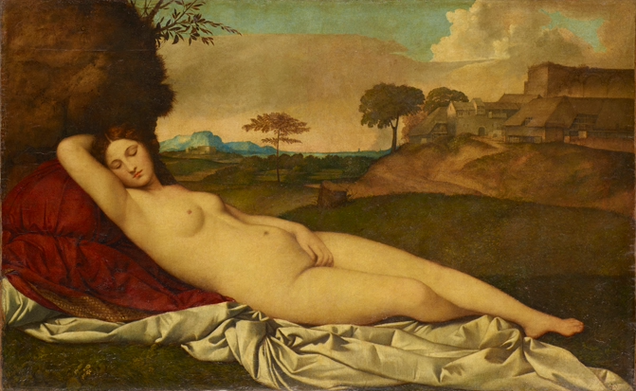
Such a powerful erotic connection between cloth and body not only has ties to a popular conceit during the Renaissance, but is also echoed in a letter written by Artemisia in 1620 to her lover, Francesco Maria Maringhi. During the Renaissance, the belief that objects could be assigned a human-like agency in artistic and literary contexts was reflected in poetry. In a sonnet by Michelangelo, a belt already embraces the waist of his beloved so a lover laments, “What then would my arms do?”8 Thus, Michelangelo suggests that an object can experience human pleasure through the imagined jealous lover. Artemisia uses a similar metaphoric device in a letter to Maringhi dated June 26, 1620, writing that “your Lordship tells me that you know no other woman besides your right hand, envied by me so much, for it possesses that which I cannot possess myself.”9Artemisia’s jealousy of Maringhi’s hand mirrors the envy of Michelangelo’s lover as they both mourn the distance from their respective beloveds.10 Therefore, as evidenced by her adoption of the object-envy metaphor in her letter, Artemisia was intimately aware of the charged associations between inanimate objects and the body, which suggests that she may have been conscious of the drapery she painted beneath Danaë and the way it caresses her nude form.
Danaë’s body as a site of erogenous tension is strengthened by the painting’s relation to another work by Artemisia painted immediately before Danaë: a reclining Cleopatra (fig. 3). The affinity between the poses of the two recumbent women has been noted before by art historian Letizia Treves, especially since they are derivative of the ancient sculpture Sleeping Ariadne.11 Artemisia was likely exposed to this sculpture through prints circulating in seventeenth-century Italy, such as the version created after the Ariadne by Dutch artist Jan de Bisschop , and likely adopted this pose for her Cleopatra (fig. 4). The ambiguity between a female figure swooning or slumbering allows for a variety of psychosomatic states to be grafted onto Ariadne’s pose by the artist. Like Danaë, Cleopatra’s right leg is tucked tightly beneath her left one and her left arm is bent behind her head, giving the impression that the two halves of her body are being stretched in opposite directions. Thus, the aforementioned tautness in Danaë’s body is also present in that of Cleopatra. Resting at the top of her solid thigh, Cleopatra’s right hand also mirrors Danaë, but with an important difference in attributes. While Danaë’s closed fist is studded with fallen gold coins, Cleopatra clutches the instrument of her imminent suicide: an asp. It might seem contradictory for Artemisia to have modeled sexual pleasure and conception after suicide, since the former emphasizes life and the latter takes it. Yet, the two contexts share something in common: both Cleopatra’s and Danaë’s bodies are on the verge of physical transformation. Recognizing this shared corporeal precipice between dying and conceiving, Artemisia ingeniously co-opts how Cleopatra embodies tension to depict the anticipation of Danaë’s erotic experience.
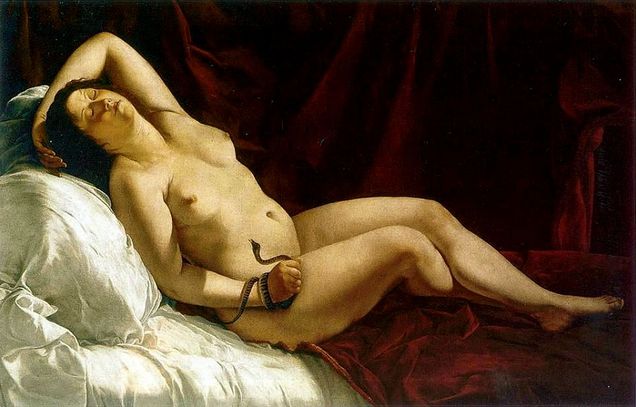
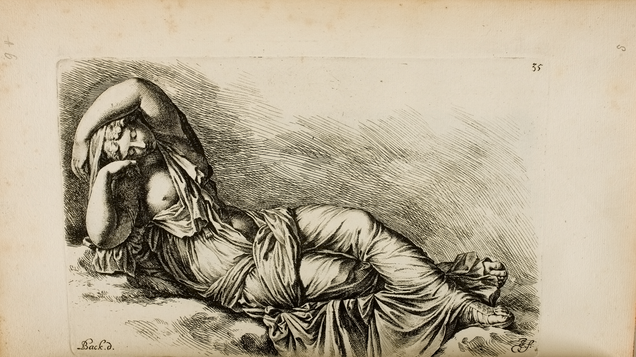
With her gold-showered Danaë, Artemisia asserts that the female body does not have just one erogenous zone but, rather, is covered in them. While the myth dictates that the multitude of gold coins landing on Danaë’s nude flesh represent a male god’s touch, these erotic, haptic moments reveal a network of explicitly female erogenous zones. It is no coincidence that some of the only coins that Artemisia depicts actively touching Danaë’s body have fallen into the crevice formed by her closely pressed thighs so that they are resting as close as possible to her vulva, an area charged with erogeneity, without actually entering it. The only other points of contact between the coins and Danaë’s flesh are in between the fingers of her clenched fist, which are bodily apertures that mimic the double folds of the labia and direct the viewer back to her lap. Even in the falling coins that have not yet touched Danaë’s bare flesh, eroticism is found in the anticipation of their imminent touch as they build a tantalizing erotic tension while suspended mid-air. Every point of contact that a coin makes, or is about to make, with Danaë’s body represents instances of touch that comprise Danaë’s journey toward her sexual climax. Danaë’s tightly pressed thighs and thrown-back head have been cited as evidence for Artemisia’s singular occupation with the difficult aftermath of her rape, but viewing Artemisia’s Danaë through the lens of female sexual pleasure dismantles this limiting, disempowering perspective.12 In its place, a complex network of erogenous zones and pleasurable reactions emerges, which demonstrates that Artemisia defined female sexual experience beyond the psychological trauma of her rape. Under Artemisia’s brush, Danaë is openly ecstatic, lost in her response to stimulating touch.
____________________
Isabella Dobson is a second year PhD student in the History of Art and Architecture at Boston University. She is interested in the ways that eroticism, desire, and sensuality operate in images of the female body from the Early Modern period.
____________________
Footnotes
1. Apollodorus, The Library Vol. I, trans. James George Frazier, (Cambridge, MA: Harvard University Press, 1921) 2.4, 153-155.
2. Mary Garrard, Artemisia Gentileschi: The Image of the Female Hero in Italian Baroque Art (Princeton: Princeton University Press, 1989), 204.
3. Scholars have traditionally seen Artemisia’s heroines as uniquely informed by her rape. To give two examples of how Artemisia’s rape is used to interpret her works, Garrard argues that the Pommersfelden Susanna and The Elders by Artemisia depicts an “emotionally distressed young woman” (189) who is “hounded on a psychological level” (198), reflecting Artemisia’s own state of mind, and later argues that Artemisa’s particularly bloody Judith Slaying Holofernes functions, in part, as a vehicle through which “to carry out psychic vengeance against her sexual oppressor” (279).
4. Mieke Bal, Introduction to The Artemisia Files (Chicago: The University of Chicago Press, 2005), xx.
5. Mieke Bal, Quoting Caravaggio (Chicago: The University of Chicago Press, 1999), 30.
6. Joanne Entwistle, “The Dressed Body” in Body Dressing: Dress, Body, Culture (Oxford: Berg Publishing, 2001), 45. Note that Entwistle derives this notion of bodily boundaries from philosopher Maurice Merleau-Ponty.
7. Jodi Cranston, “The Disordered Bed in The Sleeping Venus,” in Das haptische Bild: Körperhafte Bilderfahrung in der Neuzeit (München: Akademie Verlag, 2013), 35.
8. Cranston, “The Disordered Bed in The Sleeping Venus,” 43-45.
9. Letizia Treves, “Catalogue: A Selection of Letters from Artemisia and her Husband to Francesco Maria Maringhi” in Artemisia (London: National Gallery Company Limited, 2020), 152.
10. Artemisia wishes that her hands were giving Maringhi sexual satisfaction, when instead, her absence has forced him to masturbate on his own. This sexually explicit excerpt from Artemisia’s letter illustrates her sexual agency and desire as a woman.
11. Letizia Treves, “Catalogue,” 121.
12. Letizia Treves, “Catalogue,” 121. While it is unclear which scholars have put forth this opinion, they cite Danaë’s “pulled-back head and firmly pressed legs as signs of resistance” to support a reading of Zeus’s forceful penetration.
Skeuomorphic Textiles: Stitches in Stone
by Tracey Davison

This essay considers the ninth-century sarcophagus of St. Alkmund as a skeuomorphic funerary textile and its role in the commemoration and creation of a visible presence of the deceased (fig. 1).1 Now in the Derby Museum and Art Gallery in England, it was unearthed between 1967-68 during the demolition of the nineteenth-century St. Alkmund’s church. The sarcophagus’ ninth-century date makes Ealhmund (son of the deposed King Alcred of Northumbria) its most likely occupant; he was killed on the orders of Eardwulf of Northumbria during his exile in Mercia.2 The sarcophagus was reputedly commissioned by the Mercian king Coenwulf (c. 740-821), who may have taken the opportunity to display a martyred prince while simultaneously making a political and religious comment on the actions of Eardwulf and Northumbrian royalty.3
In considering the carved decoration of the sarcophagus, this essay suggests that we are faced with a skeuomorphic textile that emphasizes the features of woven cloth; its rich interlace pattern, demonstrated through the defining of individual strands, reveals the complexities of the weave to the viewer that are present but not visible in textile. It could be construed as a celebration of the embroiderer’s art (in its original form) and its role in denoting hierarchy through elaborate textiles used in a liturgical context.
With this in mind, it is worth exploring whether the woven structure of cloth should be considered a framework for design and how such material might be translated into stone. Skeuomorphic textiles demonstrate the unrestricted, fluid nature of Anglo-Saxon art which often integrates multiple forms of media into artistic practices. The resulting symbolism is often directly related to that of the original model. For a lay viewer, visibility and accessibility of an embroidered vestment would always be removed through the physical distance lying between clergy and congregation. The latter would be aware of the effect created by candlelight on the gold thread but would be unable to fully visualize the intricate stitches. In the case of the St. Alkmund Sarcophagus, the haptic features of the textile model, embroidered in relief upon the ground fabric, are exaggerated in the skeuomorph; the interlace carving merges the moveable aspect of the weave with the solidity of the stone, creating the ambiguity of a solid material that gives the appearance of movement and flexibility. By referencing relatively flat textiles, the teasing apart of the strands creates negative space between and behind the carving, resulting in a stone block appearing to be both solid and hollow.
The depth of the surface carving and interplay between light and shadow on the St. Alkmund Sarcophagus makes it difficult to establish where the surface design ends and the core of the monument begins. Therefore, the viewer is faced with what art historian Jane Hawkes has described as “symbolic ambiguity.”4 The precious textile recreated in the resilient stone has taken on the characteristics of the more fragile material. The stone’s solidity—its most defining feature—becomes ambiguous when rendered as a skeuomorphic textile. One of the primary purposes of cloth is to cover and protect the body; therefore, the presence of a skeuomorphic textile must be part of a visual language designed to inform the viewer about the status of the deceased as well as the nature of the original object.
This materiality has implications for the spiritual value of labor, both for the original weavers and embroiderers, and the sculptor of the skeuomorph. The use of cloth for shrouding the deceased demonstrates the important role of elaborate textiles in denoting both piety and sanctity. Almost invariably, relics are kept in protective reliquaries; the additional act of wrapping them in an elaborate textile refers to the corporeal nature of many relics (fig. 2).5 A relic may be merely a fragmentary piece of bone but it is still venerated as the living body of the saint, through the suspension of the anonymity of bodily remains and the normal laws of the grave.6 By giving the skeuomorph the appearance of being wrapped in textile, combined with the animated relief decoration representing the embroidery, the stone becomes an object of veneration and would be recognized as such. Skeuomorphic textiles can be viewed as objects of performative piety: the enhanced elements of elaborate textiles and their religious connotations are created to occupy a space and elicit a visual and emotional response.7 The interactions of the viewers or users of the skeuomorph build on this framework of familiarity, the “suggestiveness of ornament,” projecting its message forward while simultaneously acknowledging the meaning of the original textile model.8

Anglo-Saxons felt compelled to create visual symbols of power that would survive, and stone could replace the vulnerability of textile. Strength, mass, presence, and longevity are all qualities inherent to stone, but—in the case of skeuomorphic textiles—an emphasis is placed on embroidery because of its role in Church hierarchy. The gifting of elaborate textiles—especially of Eastern origin, such as silk from Constantinople adorned with religious motifs—denoted the reaches of the Christian world and reinforced the Church as a presence in both East and West.9 As noted in the later entries of the Liber Pontificalis (eighth to ninth centuries), the numerous papal donations of elite textiles to the churches of Rome raised both the profile of donor and recipient, and this status enhancement would equally apply to the patron who commissioned
St. Alkmund’s sarcophagus. A corollary to this lies in the potential of elaborate textiles as moveable furnishings, as they can journey through provenance, production, procurement, purpose and time; however, a skeuomorphic textile rendered in stone demonstrates a permanence and continuity of display.
St. Alkmund’s sarcophagus is a skeuomorphic textile which exhibits interlace as its dominant pattern, with decoration covering both the remaining section of lid and the body of the object (fig. 3). If Coenwulf’s intentions were to create a saint and a shrine, then the maintenance of an unsullied body and the condition of the clothing within the grave were of the utmost importance. This is demonstrated in Bede’s account of Cuthbert (Bishop of Lindisfarne 685-687) whose coffin was opened eleven years after his death; his body was found to be incorrupt and his liturgical vestments intact, thus elevating him to the status of saint.10 Therefore, the creation of an essentially incorruptible textile in the form of a skeuomorphic sends a powerful message about both the deceased and the patron.
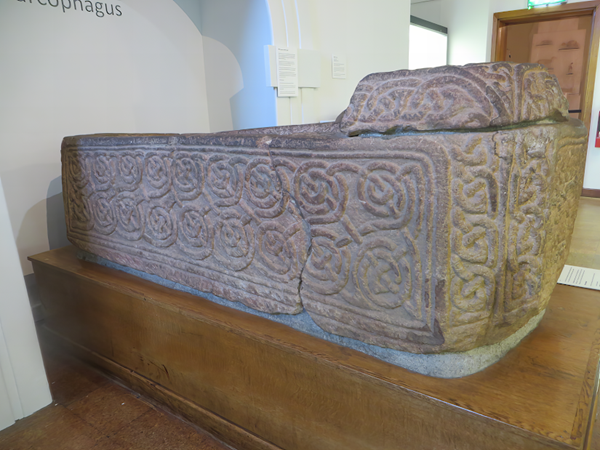
The sarcophagus was discovered broken into three sections in the south-east corner of the nave with its lid level with the twelfth-century floor of the church, meaning it had been deliberately placed to ensure its continued visibility, presumably because of its connection to St. Alkmund. As archeologist C. A. Radford has demonstrated, if the sarcophagus originally stood in the same place when above ground, it would have occupied an important position next to the altar. The reconstruction of the monument by the conservators at Derby Museum revealed a dressed stone underside, implying that it was intended to stand on the floor.11 Due to the decoration on all sides, perhaps circumambulation would have allowed for continued contemplation of the interlace pattern, thereby implying that the lack of figural ornament did not detract from the significance of the object, therefore rendering the skeuomorphic textile a contemplative tool. Furthermore, the small grains of quartz in the stone would have caught the candlelight across the undulating strands of carved interlace and highlighted the contrast between pattern and negative space.12 As the viewer moved around it, they would have been confronted by a stone coffin that combined light, shade, and carved relief that appeared to move with them. Given that a key purpose of a funerary monument is to keep the memory of the deceased alive, the monument’s capacity to physically respond to its surroundings would suggest the enduring presence of the deceased.
Compared to the figural carving on the St. Andrew’s sarcophagus, the decoration on St. Alkmund’s has been called “unambitious” by Radford (fig. 4).13 Such judgments fail to acknowledge the complexity of the non-figural, and that the production of carved interlace required skill to create the linear precision of positive and negative patterns, as well as hidden crosses. Sidebottom also implied that the decoration lacks precision, drawing attention to the variety of patterns used and the way they were combined by the sculptor(s); for Sidebottom, non-uniformity implied multiple makers.14 Yet, as a skeuomorphic textile, variation could equally point to complex patterning being embraced by the textile worker or stone carver. In this case, the scale and purpose of the piece suggests an experienced hand familiar with high-status decorative textiles.
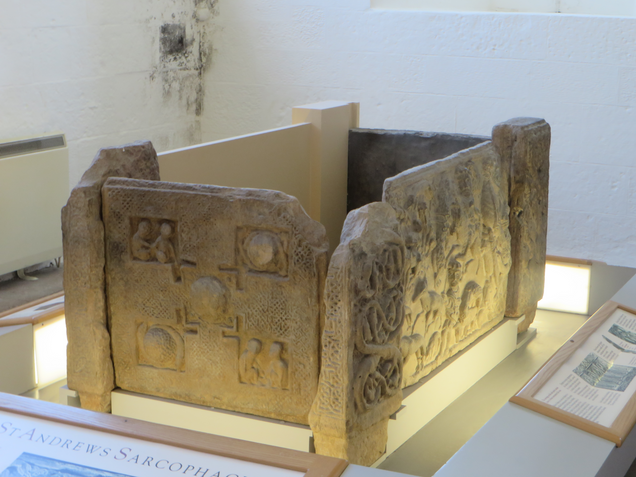
Rather than interpreting the patterns and panels as at odds with each other, they can be thought of as the separate elements that create texture and ornament akin to an embroidered textile. It may also be useful, from a skeuomorphic perspective, to imagine the panels of the sarcophagus as areas of a flat funerary textile with the tapering corner details widening towards the middle of the cloth drawing the viewer’s eye to the central decoration, which is occupied by the lid (fig. 5).
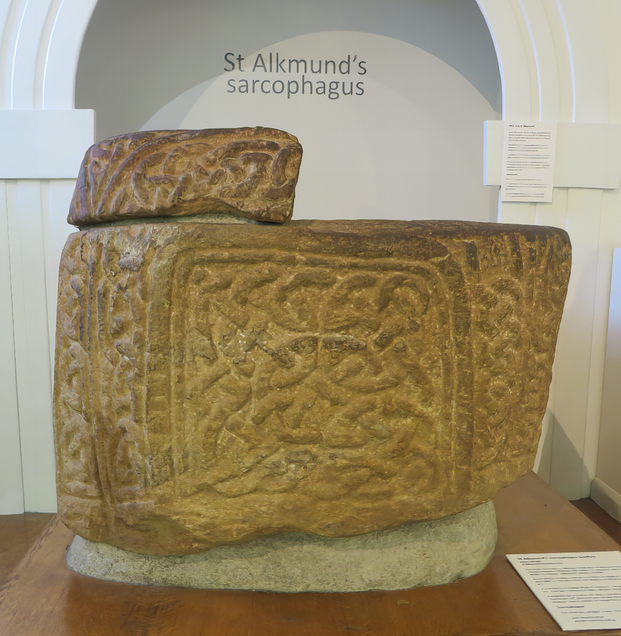
It may also be possible to explain the jumbling of pattern towards the bottom of the narrow corner panels noted by Sidebottom, not as sloppy workmanship, but rather as a faithful replication of the drape of the original textile in stone.15 In his piece on the geometry of the Lindisfarne Gospels (London, BL, Cotton MS Nero D IV), Guilmain also touches on the subject of pattern irregularity. He proposes that manipulation of pattern structure does not disturb the design; rather, it mitigates the geometric rigidity.16 Perhaps one could see this as a deliberate choice designed to represent the softer, more irregular shapes of an elaborate textile rather than the precisely drawn lines of a carpet page in a manuscript.
There is a danger that the scale of an object such as St. Alkmund’s sarcophagus may lead to physical presence overshadowing the conceptual, symbolic nature of the skeuomorph. It is important to note that the design of the skeuomorph’s textile model was a mere idea prior to being rendered in silk and gold thread. With the goal of mimesis in mind, the maker of the skeuomorph may have responded to the physical properties of the textile. Equally, they were motivated by the same considerations as the original needlewomen and the hand that draped the cloth across the coffin. In the case of a skeuomorph, it is important to consider the creative process of the maker who represented a flexible and precious textile—which would have responded to the form beneath—in resistant stone. The purpose of a funeral pall was not to hide the coffin but to “dress” it, thus acknowledging its importance. The degree of thought and contemplation required to reconcile two such disparate materials is evidenced by responses to the skeuomorphic textiles and the conviction that what we are looking at is indeed, as Boulton points out, “embroidered stones.”17
____________________
Tracey Davison is a PhD candidate in Medieval Studies at the CMS, York. Her thesis addresses the absence of a body of scholarship devoted to the use and perception of textiles and clothing in Anglo-Saxon England, examining the degree to which the art historical and archaeological evidence for early medieval textiles, clothing and adornment can be woven into and supported by the literature (vernacular and Latin, secular and ecclesiastical) produced and circulating in Anglo-Saxon England.
____________________
Footnotes
1. Skeuomorphs are defined as “powerful devices retaining a rich symbolism and possibly evoking an emotional or at least, cognitive response through their relationship with their previous incarnation of the other object, and the associated memories and significance therein.” Meg Bolton, "Embroidered Stones; Considering the Symbolism of Anglo-Saxon Skeuomorphs and the Kirkdale Grave-Slab,” in The Art, Literature and Material Culture of the Medieval World: Transition, Transformation and Taxonomy, ed. Meg Bolton, Meg Hawkes, Jane Herman (Dublin: Four Courts Press, 2015), 203.
2. D. W. Rollason, "The Cults of Murdered Royal Saints in Anglo-Saxon England," Anglo-Saxon England 11 (1982): 4.
3. Rollason, "The Cults of Murdered Royal Saints in Anglo-Saxon England," 4. “Northumbrian ambition to control the British borderlands as far south as Shropshire developed into an ambition to dominate the entire island.” T. M. Charles-Edwards, Wales and the Britons, 350-1064 (Oxford: Oxford University Press, 2014), 388.
4. Jane Hawkes, “Symbolic Lives: The Visual Evidence,” in The Anglo-Saxons from the Migration Period to the Eighth Century: An Ethnographic Perspective, ed. John Hines (Woodbridge, Suffolk, UK: Boydell Press, 1997), 334.
5. Peter Brown, The Cult of Saints: Its Rise and Function in Latin Christianity (Chicago: University of Chicago, 1980), 11.
6. Brown, The Cult of Saints, 11.
7. Howard Williams, “Engendered Bodies and Objects of Memory in Final Phase Graves,” in Burial in Later Anglo-Saxon England c. 650-1100 AD, eds. Jo Buckberry and Annia Cherryson (Oxford: Oxbow Books, 2010), 28.
8. Emmanuelle Pirotte, “Hidden Order, Order Revealed: New Light on Carpet-Pages,” in Pattern and Purpose in Insular Art, ed. Rednap et al. (Oxford: Oxbow Books, 1998), 204.
9. “On these holy martyrs’ altar he furnished 2 cloths, one of which he wondrously adorned with a gold-studded, gold-interwoven cross, the other with fourfold-woven silk; he also adorned 7 great gold-interwoven veils, sewn around with a purple fringe”. Raymond Davis, The Lives of the Ninth-Century Popes (Liber Pontificalis): The Ancient Biographies of Ten Popes from A.D. 817-891(Liverpool: Liverpool University Press, 1995), 8. The Liber Pontificalis records the biographies, decrees and church building programmes including the furnishings and elaborate textile donations of the popes between the first and the ninth century.
10. Bede, Ecclesiastical History of the English People, trans. Bertram Colgrave and R. A. B. Mynors (Oxford: Oxford University Press, 2007), I. xxix, 105.
11. C. A. Ralegh Radford, “The Church of St Alkmund, Derby,” The Derbyshire Archaeological Journal 96 (1976), 35.
12. Hawkes and Sidebottom, Derbyshire and Staffordshire, 170.
13. Jonathan Jerrett, "St Alkmund’s Derby – A Corner of Tenth-Century Europe", A Corner of Tenth-Century Europe, 2019.
14. Hawkes and Sidebottom, Derbyshire And Staffordshire, 171.
15. Hawkes and Sidebottom, 171.
16. Jacques Guilmain, "The Geometry of The Cross-Carpet Pages in The Lindisfarne Gospels," Speculum 62, no. 1 (1987): 24.
17. Meg Boulton, Embroidered Stones, 198-216.
A Piece of the “Gold Blanket”: Gardiner’s Island, Captain William Kidd, and the Gifting of Family History
by Allison Donoghue

Hidden away in Sylvester Manor, a seventeenth-century provisions plantation on Shelter Island, NY, lies a frayed scrap of green and yellow fabric only 4 3/8 x 2 ½ inches in size (fig. 1). Made of silk, cotton, and gilded silver thread, this cloth would have once shimmered in the light. The looping scrawls of a handwritten note give the fragment an abbreviated provenance: “a piece of the ‘Gold Blanket.’” The note asserts that the fabric was “...presented by the Pirate Kidd to Madame Gardiner of Gardiners [sic] Island,” and later “...presented by Mrs. Kimball to Mrs. Horsford, descendants of [illegible] Gardiner.” Carefully passed down and divided through generations of Gardiner relatives since the turn of the eighteenth century, this scrap presents a unique opportunity to study family connections and legacy in colonial North America. While contemporary family histories are recorded in genealogy books, or may be lost entirely, this piece of fabric is a material embodiment of Gardiner familial connections that has transformed over time with the family. By considering the fabric and legend through the lens of Marcel Mauss’s theory of gifting, this essay will unravel how the scrap functions to create and maintain connections and build family legacy. Family genealogies, like Cutis Gardiner’s 1890 book Lion Gardiner and his Descendants 1599-1890, court records, broadsides, local legends, and the scrap itself will support the analysis of the 'Gold Blanket' and the connections it creates.
The scrap’s bold colors and distinctive floral motif suggest its journey began in India. The fabric has a woven pattern with two distinct repeating columns, one a glimmering gold and the other a deep green. A full flower with five pink outlined petals and a green stem is visible in the gold columns. The green column is decorated with two gold flowers, cut off by the division of the textile, suggesting a repeating pattern. The five-petalled flower is a common motif found on Indian textiles beginning in the early eighteenth century.1 Europe had been importing vast quantities of Indian textiles with the best being quality embroidered silks and dye painted cottons coming from Gujarat and Bengal.2 However, designs favored by Europeans tended to feature large scale and fantastical florals and foliage on a white background.3 The small, evenly spaced patterning on the scrap could indicate that it was not originally meant for the European market before it was intercepted by Kidd. Although the origin is ambiguous, the luxurious material qualities of the fabric highlight its significant worth. Some of the finest fabrics were woven or embroidered with gilded silver threads called zari, meaning “gold.”4 The making of zari was a highly skilled and hereditary profession, passed down through families. The skill necessary to create zari, combined with the monetary value of the materials used in making the thread, resulted in a prized and expensive commodity. The zari woven into the scrap lends to the accuracy of the note’s description of the textile as a “Gold Blanket.” It continues to shimmer today and is but one small example of the intricate and sumptuous patterns that were achieved using the thread.
Although it likely originated in India, the fabric weaves together the histories of two small islands off the coast of New York State: Gardiner’s Island and Shelter Island. The former was purchased by Lion Gardiner (1599-1663) in 1636, who established the island as a Manor property and Lordship under English law.5 By the turn of the eighteenth century, Lion Gardiner’s grandson and the third proprietor of the island, John Gardiner, and his first wife Mary resided in the large manor house that lay on the West end of the 3,300-acre property.6 It was John Gardiner who first encountered Captain William Kidd in the waters off the island in 1701. This encounter made him and Mary into key figures in the legends that would form about the scrap of the “Gold Blanket.” Twelve and a half miles across the bay lies Shelter Island (fig. 2). First purchased by Nathaniel Sylvester (1610-1680) in 1651, it was originally founded as a provisioning site to provide necessities to the Sylvester sugar plantation in Barbados. He and his wife Grizzell established the family home known as Sylvester Manor. Although the current manor house was built in 1737, descendants of the Sylvester family have continuously owned the island for more than 363 years.7
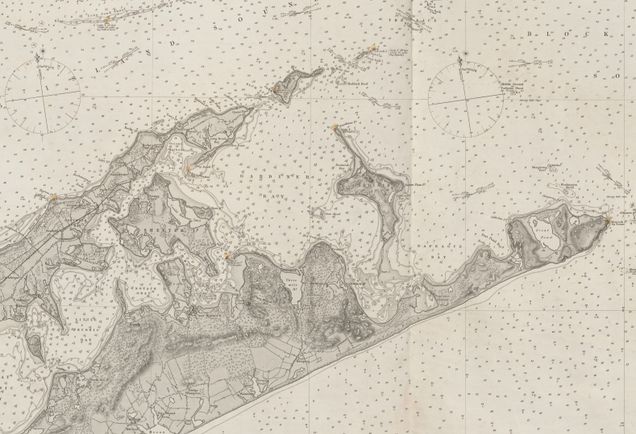
The marriage of Mary Catherine L’Hommedieu and Samuel Smith Gardiner in 1823 tied the two islands and two families together. The note accompanying the scrap records this family connection between the Gardiners and the Sylvesters and suggests the importance of the scrap in sharing and maintaining those connections. Mary L’Hommedieu Gardiner Horsford, the seventh proprietor of Sylvester Manor, was most likely the “Mrs. Horsford” referred to in the note.8 As a descendant of both Gardiner and Sylvester families through her grandparents, Mary Catherine L’Hommedieu and Samuel Smith Gardiner, she had an intimate connection to the family legend and a special claim to the fabric, which was gifted to her when it was brought from Gardiner’s Island to Sylvester Manor. The small frayed scrap was eventually placed inside the Sylvester family fireproof walk-in vault for safekeeping, along with other family heirlooms and valuables, where it remains today.
By the time the scrap reached Mary, it had already gained its own mythology through its association with Captain William Kidd. In 1695 the infamous privateer-turned-pirate Captain William Kidd became embroiled in a plot which would eventually lead to his infamy and death—as well as bring the “Gold Blanket” to Gardiner’s Island. Kidd began his piratical exploits in 1697 off the Malabar Coast in the Indian Ocean.9 He captured several ships, but his most lucrative prize was the Quedagh Merchant, a large Indian merchant vessel returning to Surat, Gujarat, an important commercial center for the east Asian textile trade during the 17thcentury.10 The Quedagh Merchant contained “60-80 chests of opium, 20-30 bales of silks, 200-300 bales of sugar, and 500-600 bales of calicoes, muslins, and other East India goods”—an estimated value of 200,000-400,000 rupees.11 Kidd’s pirating ended in 1701 when he was captured while visiting the Governor of Massachusetts, his former friend and patron Lord Bellomont, and brought to England for a three-day trial.

England and the American colonies became fascinated with Kidd’s macabre crimes and trial, as evidenced by several “true” accounts of his behavior, confession, and “dying words” that were published in London broadsides and circulated to the gossip-hungry public during and after his execution.12 Printed on large sheets of paper, broadsides were tabloids that appealed to a wide range of social classes.13 They were often distributed at public executions but could also be found in other public spaces like taverns and marketplaces. Two of these broadsides were written by the chaplain of Newgate prison, Paul Lorrain. His publications especially highlighted Kidd’s refusal to confess to his crimes, drunkenness, and general lack of repentance and morals. Authors highlighted lurid details to emphasize the sinfulness of the criminal and appeal to the public. Several ballads and songs about Kidd were also published and disseminated, most notably Captain Kid’s Farewel to the Seas [sic].14 The proliferation of print material surrounding Kidd’s trial demonstrates the public’s hunger for the grim details and salacious stories relating to Kidd’s piracy. It was in this period of immense public interest surrounding Kidd’s trial that the legend around the scrap began to develop.
According to John Gardiner’s statement, which was published in court documents relating to Kidd’s trial, the encounter between Kidd and Gardiner in 1701 was amicable, although Gardiner was then unaware that Kidd had been accused of piracy.15 Gardiner allegedly met Kidd on his sloop anchored off Gardiner’s Island where they began bartering. Kidd gave Gardiner two “bales of goods” and requested “six sheep.” The formal trading done, Kidd asked Gardiner if he could spare a “Barrel of Cyder [sic].” In appreciation of Gardiner’s generosity, Kidd gifted him “…several pieces of damnified Muslins and Bengals, as a Present to his wife” as well as “three pieces of damnified Muslin” for Gardiner’s own use and “Four pieces of Arabian Gold.” The description of the gifted cloth as “damnified,” meaning to inflict injury or loss, suggests that the cloth may already have been damaged at the time it was gifted to Gardiner. It was after this initial exchange that Kidd requested that Gardiner keep a portion of his treasure on the Island, including a “box of gold,” a “bundle of Quilts,” and “bundle of goods.”16
French anthropologist Marcel Mauss’s theory of gift exchange, put forth in his seminal work, The Gift (1925), provides a lens with which to analyze this interaction. Mauss argues that gifts are not truly given freely. The gift “possesses something of [the giver]” and therefore is not “inactive;” it imposes obligations that must be fulfilled and reciprocated.17 According to Mauss, a gift, when given, creates a “debt” that is not fulfilled until it is reciprocated. The obligations, or debt, created by gifts forge connections and build bonds between giver and receiver.18 By accepting Kidd’s gifts Gardiner entered a reciprocal relationship with Kidd. The initial bartering, a seemingly equal exchange of “bales of goods” for “six sheep” is notably different from the extravagant presents Kidd gave Gardiner. The cloth and “Arabian gold” seem out of proportion in value as a gift when compared to “a Barrel of Cyder.” It is notable that it is only after the exchange of gifts that Kidd requested Gardiner keep his illicit treasure on the island. Perhaps Kidd’s “generosity” influenced Gardiner’s decision to keep the treasure safe. This exchange—the gifting of the gilded cloth and the concealment of Kidd’s treasure—brought the scrap of golden blanket to the island and into circulation within the Gardiner family. This interaction also placed the Gardiner family into the developing lore surrounding Kidd.
Curtis Gardiner recorded the family legends that formed about the encounter over the next two centuries in Lion Gardiner and his Descendants 1599-1890. There are several different stories, the tale becoming increasingly embellished with generations of retellings. In one version the fearsome Captain Kidd broke down the door to Gardiner Manor, rousing John Gardiner from bed and hiding his loot “in a swampy place at Cherry Harbor.”19 In another, Kidd tied Gardiner to a mulberry tree and demanded that Mrs. Gardiner roast him a pig, which was so delicious that he gifted her the cloth of gold.20 Curtis was generally skeptical of the folklore and very concerned with the lack of “proof” these family traditions offered.21 However, he chose to include them in his book because “certain pious family fictions…must not be disturbed.”22 Although embellished and fantastical, the stories provided an oral tradition that imbued the cloth with meaning and connected the family to the salacious pirate.
The family placed significant value on the scrap and the family lore it carried, splitting it into smaller pieces and passing it down as an heirloom for nearly one-hundred and thirty-five years. Curtis reveals the continued journey of the fabric from generation to generation. He writes that a Mrs. Wetmore, great-granddaughter of Mary Gardiner, heard from her mother that Kidd “...made [Mary] a present of the silk, which she then gave to her two daughters.” It was presumably Mary who originally divided the fabric between her daughters. Mrs. Wetmore eventually received the fabric passed down to her by her mother, well preserved and cared for by each generation as it was “…now as good as when first given…upwards of one hundred years ago.”23 Hidden in his footnotes, Curtis Gardiner confided that while visiting Gardiner’s Island in August of 1835, he too was gifted a small clipping of the golden blanket from one of the “remnants.” This clipping was presented to him by Mrs. Sarah Griswold Gardiner, the “widow of the seventh proprietor,” John Lyon Gardiner.24 The continued gifting of the scrap within the Gardiner family is significant, as the exchange of the scrap facilitated and fortified family relationships. The golden blanket had become what might be considered an “inalienable” object.25 Per anthropologist Annette B. Weiner, inalienable objects are unique because they are inherently tied to their original owners, which adds “cultural meanings of wealth” that are separate from alienable objects which are not closely tied to a specific family or history.26 These objects, like the “Gold Blanket”, are powerful because they “define who one is in an historical sense” becoming “…an intimate part of a person’s present identity.”27 As an object tied to the identity of the Gardiner family, the scrap’s value as an heirloom exceeded that of its material worth.
As the children and grandchildren of John and Mary Gardiner married and left the island, the scrap remained an important tie to their family history. The scrap was evidence of the Gardiner family lore and the connection between distant family members. Today a second, nearly identical, piece of the “gold blanket” resides at the East Hampton Library on Long Island. This fragment is a similar size to the Sylvester Manor sample and is mounted on a black backing inside a gilded frame.28 A popular attraction, stories are written about the scrap in local newspapers every few years. Some of these stories closely echo the family folklore: one label reads, “Kidd broke into the manor house at night…hiding his treasure in the swampy area” off the island and leaving the family with threats of death.29 Others implicate John Gardiner in the legend, one blog writing, “…the Gardiners of Gardiner’s Island…tipped Lord Bellomont on to [Kidd’s] presence” suggesting Gardiner betrayed Kidd’s location and treasure to authorities.30 The continued publication and circulation of the legend maintains the scrap’s connection to the Gardiner family. This remnant was originally a loan from a member of the Gardiner family on occasion of the library’s 40th anniversary in 1937, but later became part of the permanent collection. This new act of gifting expands the scrap’s network into the twenty-first century, connecting the Gardiners to the East Hampton Library and the larger community. This connection, facilitated and materialized by the scrap, reinforces the Gardiner family’s long history and ties to the local community as descendants of early colonists, founders of Gardiner’s Island, and current Lords of the Manor. The library protects and preserves the scrap—and the family history which it embodies—while simultaneously making it more accessible to the public. The preservation of the scrap within the library weaves together the broader history of colonial textile trade beginning in India, the intimate family history of the Gardiners, and the current community of East Hampton, creating a shared bond through the legend of Captain Kidd.
____________________
Allison Donoghue is a second-year master’s student at the Bard Graduate Center of Decorative Arts, Design History, and Material Culture. She approaches history from an interdisciplinary lens, centering her work around material culture. She is broadly interested in gender, trade, and the relationship between Europeans and Indigenous people in 17th century New England and New Amsterdam.
____________________
Footnotes
1. As a global center of the textile trade, Indian textile manufacturers sold to many markets including Indonesia, Thailand, Europe each with a distinctive preference in floral styles and patterns.
2. Ebeltje Hartkamp-Jonxis, When Indian Flowers Bloomed In Europe: Masterworks of Indian Trade Textiles, 1600-1780, In the Tapi Collection (New Delhi: Niyogi Books, 2022), 9-10.
3. Avalon Fotheringham, The Indian Textile Sourcebook (London: Victorian and Albert Museum, London/Thames & Hudson Ltd, 2019), 47.
4. Vandana Bhandari, Jeweled Textiles: Gold and Silver Embellished Cloth of India (Uttar Pradesh: Om Books International, 2015), 26.
5. Gardiner purchased the property first from the from Montaukett Sachem Wyandanch in 1636 and then again from Earl of Stirling in 1639 who had been given the property by King Charles I. Curtis Gardiner, Lion Gardiner and his Descendants 1599-1890 (St. Louis: A. Whipple Publisher, 1890), 58.
6. Gardiner, Lion Gardiner and his Descendants 1599-1890, 97.
7. “History,” Sylvester Manor, Accessed November 20, 2023, History — Sylvester Manor.
8. Alternatively, the note could refer to Mary’s sister, Phoebe D. Gardiner (8th proprietor of Sylvester Manor), who married Eben Norton Horsford (Mary’s husband) after Mary’s death in 1855. Both Mary and Phoebe were direct descendants of the Sylvester and the Gardiner family through their grandparents, Mary Catherine L’Hommedieu and Samuel Smith Gardiner. Mac Griswold, The Manor: Three Centuries at a Slave Plantation on Long Island (New York: Farrar, Straus and Giroux, 2013), 3.
9. Recently there has been significant debate over whether Kidd was truly a pirate. For a detailed account of Kidd’s life and piracy see, David Wilson “Piracy, Patronage & Political Economy: Captain Kidd and the East India Trade” International Journal of Maritime History 27, no. 1 (March 2015): 26–40; and Frederick Hanselmann, Captain Kidd’s Lost Ship: The Wreck of the Quedagh Merchant. (Gainesville, FL: University Press of Florida, 2019).
10. John Guy, “One Thing Leads to Another: Indian Textiles and the Early Globalization of Style,” in Interwoven Globe: The Worldwide Textile Trade, 1500-1800, ed. by Amelia Peck (New Haven: Yale University Press, 2013), 14.
11. David Wilson, “Piracy, Patronage & Political Economy,” The International Journal of Maritime History 27, no.1 (March 2015.): 34-35.
12. Paul Lorrain, The Ordinary of Newgate His Account of the Behaviour, Confessions, and Dying-Words of Captain William Kidd, and Other Pirates, that were Executed at the Execution-Dock in Wapping, on Friday May 23, 1701 (London: 1701); And A True Account of the Behaviour, Confession and Last Dying Speeches, of Captain William Kidd, and the Rest of the Pirates, that were Executed at Execution Dock in Wapping, on Friday the 23d of May 1701. Licensed According to Order. (London: 1701).
13. Sarah F. Williams, “‘A Swearing and Blaspheming Wretch’: Representations of Witchcraft and Excess on Early Modern English Broadside Balladry and Popular Song,” Journal of Musicological Research 30, no. 4 (Oct-Dec 2011): 314.
14. The “Elegy on the Death of Capt. William Kidd,” the “Dialogue Between the Ghost of Captain Kidd and the Napper in the Strand,” and “The Dying Words of Capt. Robert Kidd” were other ballads that gained popularity at the time of his trial. For a detailed analysis of these ballads see William Hallam Bonner, “The Ballad of Captain Kidd,” American Literature 15, no.4 (Jan 1944): 362-380.
15. Graham Brooks, Trial of Captain Kidd (Glasgow: William Hodge and Company, 1930), 215.
16. Brooks, Trial of Captain Kidd, 215-216.
17. Marcel Mauss and W. D Halls, The Gift: The Form and Reason for Exchange In Archaic Societies (New York: W.W. Norton, 2000): 15.
18. Mauss and Halls, The Gift, 15.
19. Gardiner, Lion Gardiner and his Descendants 1599-1890, 97.
20. Gardiner, 98.
21. Gardiner, 98.
22. Gardiner, 98.
23. Gardiner, 98.
24. Gardiner, 98; Jeannette Edwards Rattray, East Hampton History Including Genealogies of Early Families (New York: Country Life Press, 1953), 343.
25. Annette Weiner, “Inalienable Wealth,” American Ethnologist, no. 12 (1985): 210.
26. Weiner, “Inalienable Wealth,” 210.
27. Weiner, 210.
28. "Captain Kidd cloth of gold," Collection Highlights, East Hampton Library, Accessed October 4, 2022.
29. Colette Gilbert McClain, “Overheard: Fantasy Island,” East Hampton Star, September 12, 2022.
30. “Buried Treasure on Long Island,” Crime Capsule, accessed November 25, 2023, Buried Treasure on Long Island - Crime Capsule; “Captain Kidd and Gardiner: The Legendary Treasure Revealed.” Dan Rattiner, last modified August 27, 2022, Captain Kidd and Gardiner: The Legendary Treasure Revealed (danspapers.com).
2023 James and Audrey Foster Prize
Institute of Contemporary Art/Boston Aug 24, 2023 – Jan 28, 2024
by Michelle Kelley
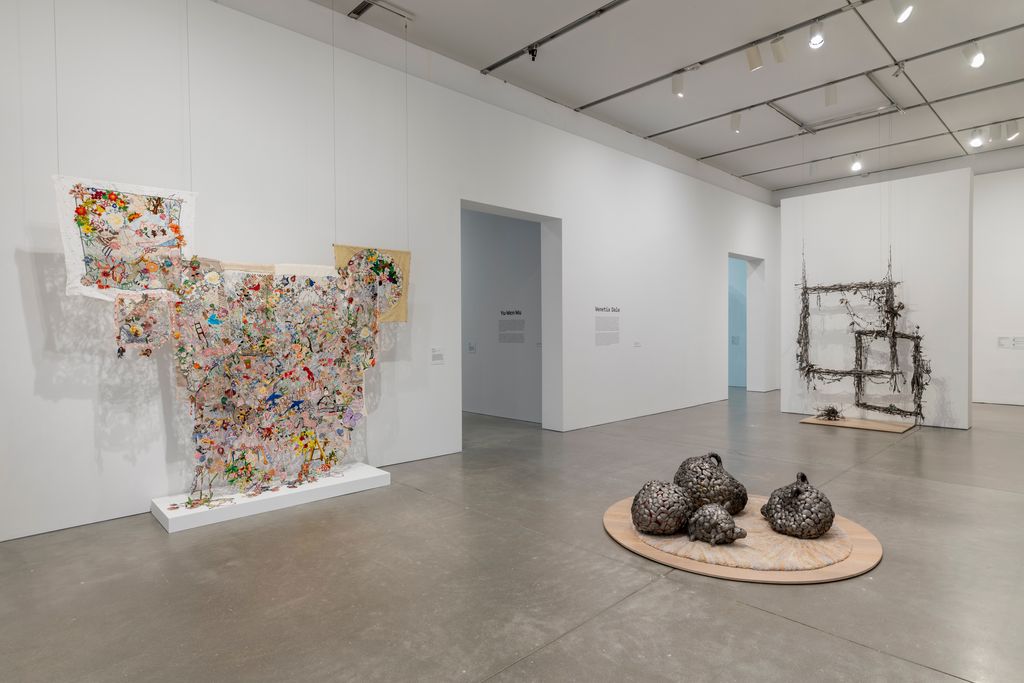
Established in 1999, the James and Audrey Foster Prize is biennially awarded to working artists based in the Boston area. The recognized artists for the 2023 James and Audrey Foster Prize exhibition at the ICA/Boston—Venetia Dale, Cicely Carew, and Yu-Wen Wu—are three artists who share a common thread: their commitment to innovative material usage, repetitive action, and emotional connection to their work.
Upon entering the gallery, visitors are greeted by the work Piecing Together: 50 years, which Dale constructed from others’ abandoned embroidery projects. The sheer volume and variety of these remnants points to the almost-universal nature of leaving a project unfinished. Like these fiber works, Dale’s cast-pewter pieces embody the “caretaking” that Dale references frequently in her art⏤finding a new purpose for what others have abandoned. The gradual gathering of something and Thresholds of Care: kitchen windows (sisters) are two works composed of several pewter casts made, respectively, from orange peels discarded by her young son, and living and dead houseplants collected by Dale and her sister; they speak to Dale’s regard for what others might write off as waste. Her castings also evoke the image of Dale nurturing her small child while finding a productive use for his cast-offs. In tandem with the unfinished embroidery projects of Piecing Together, Dale’s pewter works repurpose objects that are otherwise abandoned. Again and again, Dale’s sculptures reflect a choice to continue attending to objects others might dispose of, as she stitches together a multitude of incomplete embroideries and casts numerous peels and plants in the service of each work. In the case of Thresholds, after she failed to adequately provide for a houseplant, the plant endures in her sculpture. In the gradual gathering of something, she memorializes a moment in time—one where her child required ample assistance and supervision—by casting the impermanent in metal. Her choice to use pewter and textiles, as well as the presence of contributions from Dale’s family, lend the pieces a domesticity and intimacy that is made more apparent by the fact that Dale has chosen these materials explicitly because she can manipulate them in the home.1

Carew similarly makes use of discarded materials, albeit ones that are more industrial in nature. Spray-painted plastic netting and plastic foliage, densely arranged and connected with colorful zip ties, are gathered into works including Whether Weather and The Overflow that appear to float against the pale blue gallery walls. The lighter-than-air quality of these works is in sharp contrast with their bulky silhouettes. Carew refers to the construction of these “flying paintings” as “composting.”2 Her sculptures give new life to this packaging material, just as compost turns waste into nutrient-rich soil. While the use of this metaphorical “compost” and the inclusion of a patch of artificial grass in the center of the gallery for visitors to walk on ties Carew’s practice to the earth, her maximalist sculptures appear weightless, hanging from the ceiling or emerging fully formed from the wall. They serve as a vivid reminder for viewers that there is potential for visual pleasure in the humblest material.

In the third gallery, Wu’s works experiment with diverse materials, as is fitting for an artist who has frequently approached her work with scientific precision. Intentions is a standout piece in this gallery. Here, Wu strings together balls of dried and gilded tea leaves with red thread and hangs the strands from ceiling to floor. The strands are intended to reference the prayer beads used by the artist’s grandmother—a memory of her life in Taiwan. For the viewer, this piece invokes a tactile dimension as they are prompted to imagine the act of handling beads, while the use of tea suggests warmth and community. The materials used also point to Wu’s Taiwanese background, which she speaks candidly about when discussing her work. Wu has shared the pressure she experienced to assimilate into American life after immigrating from Taiwan in the 1970s, and how she was encouraged to completely leave behind her native language and culture in order to fit in.3
In another work, Acculturation, Wu pins leaves from Taiwanese tea and local New England plants, some gilded, to the wall in an orderly grid that could read almost as a specimen collection of plants from before and after her transition to American life. Per Wu, this gilding references America’s mythical streets paved in gold—an unrealistic ideal of this country held by many immigrants prior to their arrival in the United States.4 Gilding also reflects her desire to transform ephemeral material into something more enduring and equalize the foreign tea with locally sourced leaves. Other materials, including the red thread, tea, lotus leaves, and porcelain, point to her Taiwanese heritage. The inclusion of diverse material in her exhibition is an additional nod to the hybridity of her immigrant experience and transition into life in America. Additionally, Wu noted that much of the tea she uses has been brewed by her family in Taiwan, dried, and sent to her for her use in artwork.5 As with Dale and Carew, Wu takes inspiration in material that many would view as refuse: in this case, used tea leaves.
The recipients of this year’s Foster Prize all present works composed of diverse materials, and all are inspired by their familial ties. Carew acknowledges that the birth of her son encouraged her to commit more fully to her artistic practice.6 The evocation of environmental concerns in her work is perhaps similarly motivated by a desire to leave him a better world. In the same vein, Dale’s works reflect the practical changes motherhood had on her art, both materially and inspirationally, as her work with embroidery and fiber began during her pregnancy, when she had to forego pewter due to the chemicals involved in its casting. Furthermore, Wu threads the needle between rational approach and emotional inspiration as she draws upon her family’s immigration experience in the 1970s and subsequent transition into American society. Though all three recipients work in disparate media, their works focus on ideas of waste and renewal, and their dual identities as individual artists and members of a family. This hybridity is further reflected in the choice of materials that are both precious and modest, durable and ephemeral, throughout the galleries.
____________________
Michelle Kelley is an MA student in the Department of History of Art and Architecture at Boston University with diverse interests including museum engagement, materiality, and modern/contemporary art. She holds a BA in Art History and English from the College of William and Mary, where she served as President of the Muscarelle Museum University Student Exchange. Michelle interned at the Smithsonian’s Hirshhorn Museum and Sculpture Gallery as an Interpretive Guide. Afterward, Michelle worked in a D.C. metro-area antique and fine art auction house.
____________________
1. Venetia Dale, “The Artist’s Voice: Cicely Carew, Venetia Dale, and Yu-Wen Wu with Assistant Curator Anni Pullagura” (conversation, ICA/Boston, September 28, 2023).
2. Kris Wilton, Studio Visit: Cicely Carew. ICA/Boston, August 2023, video, 4:30, https://www.icaboston.org/multimedia/studio-visit-cicely-carew/.
3. Yu-Wen Wu, “The Artist’s Voice: Cicely Carew, Venetia Dale, and Yu-Wen Wu with Assistant Curator Anni Pullagura” (conversation, ICA/Boston, September 28, 2023).
4. Wu, “The Artist’s Voice.”
5. Wu, “The Artist’s Voice.”
6. Dale, “The Artist’s Voice.”

